Cruise Maven
Cruising the World One Port at a Time

Can You Get Seasick on a River Cruise?
By: Sherry Laskin · Updated On: February 23, 2021
It’s extremely rare for anyone to get seasick on a river cruise. First, there are virtually no waves on a river. Sure, it can get windy, but waves and rocking are almost non-existent. If your river ship is tied up in port at night, you might experience a slightly gentle sway now and then when a cargo boat goes past.
And speed? Hardly. River ships move at only a fraction of the speed of ocean cruise ships. Slow enough in fact, that you can read the nautical mile marker signs along the river banks. And with the shoreline always in sight, there’s always something to watch to get your mind off any queasiness you might encounter. But it’s rare that anyone feels ill. In my ten years of river cruising I’ve never seen anyone wearing a seasick patch nor mention a bout of mal de mer.
There are some places, like on the Volga in Russia or parts of the Mississippi, where the river seems to open up and you feel like your on a lake rather than a river. But it is only for a few minutes and then the river narrows again.
Back to River Cruise FAQs
Get Cruise Maven’s Newsletter
Get Our Latest Posts With Cruise and Travel Tips, News and Reviews!
About Sherry Laskin
I'm the editor and creator of CruiseMaven.com, a solo traveler cruising the world without flying. I hope my articles and photos entertain, advise and inspire you to travel the world without flying. Take a breath...stop for a local meal and a glass of wine along the way.
Related Posts

Why I Love Portland Maine on a Canada New England cruise

Become an Insider!
Get Cruise Maven's newest articles, travel advice, cruise reviews, destinations and more.
For over twenty-five years, I've been traveling the world without flying, by only river ships, ocean ships, road trips and trains. I hope to inspire you to travel slow, explore new places, experience different cultures and taste new cuisine. Follow my solo travel adventures across the USA, North America and the world!
Places to Go
- Sitka, Alaska
- Monte Carlo
- Mount St. Helens
- Florence, Italy
- Paris, France
Cruise Reviews
- Radiance of the Seas
- Crystal Serenity
- HAL Eurodam
- Viking Star
- Alaskan Dream Cruises
- Pique Sauce
- Jalapeño Poppers
- Guy’s Straight-Up Burger
- Oatmeal Chocolate Chip Cookie
- Pesto Sauce
River Cruises
- Viking Grand European
- AmaWaterways Christmas Markets
- Columbia and Snake Rivers
- AmaKristina Rhine River
- CroisiEurope Deuce France
Copyright © 2024 Cruise Maven · Theme by 17th Avenue
Updated on February 23, 2021 by Sherry Laskin

- Connect on Facebook
- Follow on Twitter
- RSS for Entries
- Subscribe via Email
- About WAVEJourney
- Travel Bloggers Influencer Network – #TBIN
- TBINChat on Twitter – #TBINChat #TBIN
- Bucket List Travelers Travel Advisor Services
- WJ Contributors
- Writer’s Guidelines
- Privacy Policy – WAVE Journey
- Full Disclosure
- Book Travel
- Ocean Cruises
- River Cruises in Europe
- Hotel Barge Cruises
- Adventure Cruises
- Small Ship Cruises
- River Cruises in the USA
- River Cruise on the Mekong River
- Sailing Cruises
- Halong Bay Cruise
- Travel Tours
- Travel Deals
- Trip Planning Resources
- Before You Leave – Resources & Tools
- Cruise Reviews
- Train Travel
- Travel Tours for Disabled
- Women’s Travel Blogs
- Camino de Santiago
- Horse Riding
- RVing for Women
- Water Sports
- Winter Sports
- Great Places to Sleep
- Gear and Gadgets
- Clothing and Footwear
- Great Eats and Drinks
- Featured Photos
- Central & South America
- Great Britain
Seasickness on a River Cruise?
Sharing is caring!
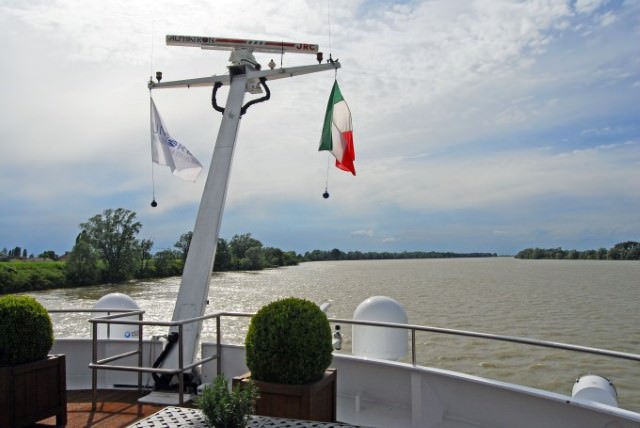
Cruising on the Po River aboard Uniworld River Countess
WEEKLY RIVER CRUISE TRAVEL TIP – JANUARY 28, 2015
By WAVEJourney
Q: Will I suffer from seasickness on a river cruise?
A: It’s highly unlikely that even the most motion sensitive people will suffer from seasickness on a river cruise. The rivers in Europe do not have much motion to them at all, and the river ships are extremely stable. If you are prone to suffering motion sickness from even the slightest movement on the water, try Sea Bands or take an over-the-counter motion sickness remedy. The good news is, 99.9% of river cruisers barely notice the ship is cruising – so you’ll probably be just fine.
You Might Also Enjoy...

Leave a Reply Cancel reply
You must be logged in to post a comment.
Since 2005... Viv Chapleo & Jill Hoelting are the dynamic duo behind WAVEJourney.com - Women's Adventures, Vacations & Experiences ~ Your Journey Starts Here!
WAVEJourney.com is a women's online travel magazine that provides valuable first-hand travel tips, tales, steals and deals to a world-wide audience.
Search WAVEJourney.com
Sign up for wj’s free monthly newsletter, wavejourney is a member of tbin.

WAVEJOURNEY IS A MEMBER OF ATTA
Contact the adventure creators for custom pyrenees trips.

ROAMING MAN 4G WORLDWIDE WI-FI HOTSPOT

DO YOU DREAM OF BEING A TRAVEL WRITER?
Finding it hard to break into the travel writing business?
Linden Gross, a two-time New York Times bestselling writer—and a writing coach to other bestselling writers—offers one-one-one travel writing coach sessions .
And when your piece is ready, you can publish it on her TravelswithLinden website and get that all-important first online clip.
POPULAR POSTS
- Travel USA: Wine, Sunsets and Jazz in Key West
- Travel Greece: A Glimpse of the Greek Islands
- Travel Portugal: How to Ride Porto’s Metro System
- WJ Tested: Scottish Highlander Hotel Barge Review
CroisiEurope Deborah Hotel Barge Cruise in France
Wj tested: costa mediterranea norway cruise review, wj tested: costa mediterranea norway & northern europe itinerary highlights.
- Hiking Tour of the Camino de Santiago with Portugal Green Walks
WJ Tested: Celebrity Cruises Silhouette Transatlantic Itinerary Highlights
Wj tested: celebrity cruises silhouette transatlantic cruise review, wj tested: holland america line nieuw statendam review, march 2019 travel tips and tales newsletter.
- February 2019 Travel Tips and Tales Newsletter
- Travel Wisconsin: Osthoff Resort Christmas Market
Travel Canada: The Best Way to Spend 72 Hours in Quebec City
- January 2019 Travel Tips and Tales Newsletter
- Cruise to Bermuda with Celebrity Cruises
Travel Washington: Bellingham is Ideal for Lovers of Beer & Adventure!
- Travel USA: Washington, DC – The Heartbeat of America
- Cruise Bermuda on Royal Caribbean Serenade of the Seas
A NEW KIND OF TRAVEL OUTLET
Are you a traveler looking for a resource that goes beyond the basic guidebook?
Or maybe you’re a travel writer still looking to hone your craft and finally publish your work.
Either way, check out the highly subjective and positively personal TravelswithLinden.com .

Maine Windjammer Adventure on Schooner Mary Day

Adventure of the Seas Canada & New England Cruise – Day 11

Adventure of the Seas Canada & New England Cruise – Day 10

Adventure of the Seas Canada & New England Cruise – Day 9
March 2019 Travel Tips and Tales Newsletter By WAVEJourney Greetings! Spring is here in the Northern Hemisphere and WJ has big travel plans! How about you? Chat with us and let us know where you’re going, what you’re doing, and ask for the advice and travel tips you need to enhance your adventures. After a […]
Added By WAVEJourney on 03/26/2019
WJ NEWSLETTERS
TRAVEL CANADA: QUÉBEC WINTER CARNIVAL
Wj tested: discovering history-rich quebec city, travel canada: exploring quebec’s eastern townships, connect with us.
- Destinations
- Privacy Policy
© 2015, ↑ WAVEJourney
Privacy Overview
How to Prevent Seasickness on a Cruise

Do you want to plan a cruise, but you’re worried about getting seasick? The excitement of embarking on a cruise to exotic destinations can quickly fade if you’re prone to seasickness. That queasy feeling can turn your dream vacation into a nightmare.
Fortunately for you, we’ve got your ticket to smooth sailing!
What Causes Seasickness?
Seasickness, also known as motion sickness, is a common condition that occurs when your brain receives conflicting signals from various sensory systems in your body. It primarily arises when you’re on a moving vessel, such as a boat, ship, or cruise, and can result from the following factors:
Sensory Confusion: Your inner ear (vestibular system) plays a crucial role in maintaining balance and spatial orientation. When you’re on a moving ship, your inner ear detects the motion, while your eyes may see a relatively stable cabin or surroundings. This sensory mismatch between what your inner ear feels and what your eyes perceive can lead to motion sickness.
Inconsistent Signals: Seasickness can also be triggered by other senses, including touch and proprioception (the body’s sense of its position and movement). For example, feeling the motion of the ship beneath your feet while standing on a deck can be unsettling if your eyes see a stationary horizon.
Nausea and Vomiting Reflex: When your brain receives conflicting sensory signals, it may interpret this as a potential threat, leading to the activation of your body’s nausea and vomiting reflex as a protective mechanism.
Individual Susceptibility: Some people are more prone to motion sickness than others. Genetics may play a role, as susceptibility can run in families. Hormonal factors, such as those related to pregnancy, can also influence vulnerability to motion sickness.
Prolonged Exposure: The longer you are exposed to motion without relief, the more likely you are to experience motion sickness. This is why some people may feel fine initially but develop symptoms as the journey continues.
Environmental Factors: Weather conditions, such as rough seas or turbulent air for those on airplanes, can exacerbate the sensation of motion and increase the likelihood of seasickness.
It’s important to realize that seasickness can vary in severity from person to person. For some, it can be a minor discomfort, while for others, it can be severely debilitating. It’s also worth noting that you are much less likely to experience seasickness on a river cruise as opposed to an ocean cruise.
Fortunately, there are a handful of strategies and precautions you can take to prevent seasickness and ensure a pleasant time while on your cruise. Let’s dive in, shall we?
1. Choose Your Cabin Wisely
The location of your cabin can make a significant difference in your cruise experience. Cabins located in the middle of the ship, close to the waterline, tend to experience less motion. Aim for a mid-ship cabin if you’re worried about seasickness.
2. Medications and Remedies
Several over-the-counter and prescription medications can help prevent or alleviate seasickness. Consult with your healthcare provider before your cruise to discuss the best option for you. Common medications and natural treatments include:
Dramamine and Bonine: These are over-the-counter medications that are effective at preventing seasickness. Take them as directed, typically before boarding the ship.
Scopolamine patches: These prescription patches are applied behind the ear and can provide relief from seasickness for up to three days.
Ginger: Natural remedies like ginger candies, ginger tea, or ginger supplements can help alleviate nausea.
Acupressure wristbands: These wristbands target specific pressure points to reduce motion sickness symptoms.
3. Stay Hydrated and Eat Lightly
Dehydration can worsen symptoms, so make sure to drink plenty of water throughout your cruise. Additionally, opt for light, easily digestible meals and avoid heavy, greasy, or spicy foods, which can exacerbate nausea. And maybe take it easy on the complimentary alcohol as well.
4. Keep Your Eyes on the Horizon
When you’re on the deck, focus on the horizon. This helps your brain reconcile the conflicting signals it receives from your inner ear and your vision, reducing the sensation of motion sickness.
5. Avoid Activities That Worsen Symptoms
Reading, watching videos, or staring at screens can make seasickness worse. Instead, engage in activities that don’t require intense focus or visual attention. Listen to music, socialize with fellow passengers, or simply relax and take in the sea breeze.
6. Stay Well-Rested
Fatigue can increase the likelihood of seasickness, so ensure you get enough rest before and during your cruise. A well-rested body is better equipped to cope with motion.
7. Pre-Cruise Preparation
Start your preventive measures before you even board the ship. Take your chosen medication or remedy according to your healthcare provider’s recommendations well in advance of your cruise. This allows the medication to become effective and minimizes the risk of seasickness.
8. Trust the Crew
Crew members are well-versed in dealing with seasickness. If you’re feeling unwell, don’t hesitate to contact the ship’s medical staff. They can provide additional medications or treatments to help you feel better and enjoy your cruise.
With these preventive measures in place, you can hit the seas with confidence, knowing that seasickness won’t be a hindrance on your cruise vacation . By taking steps to prepare you can focus on the breathtaking scenery, incredible excursions, and unforgettable experiences that cruising has to offer. Bon voyage!
- Best of the Northwest
- Travel Abroad
- Travel Health
- Travel Warnings
- US Travel Security
- Vessel Sanitation Program
- Airline On-Time Stats
- Airline Status
- Portland City Tours, Oregon Wine Tours, Mt. Hood Tours
- World Clock
- Travel Agents
- Travel Insurance
- Video Gallery
- Cruise Recipes
Sign up for our e-Newsletter & receive exclusive offers!
10000 NE 7th Ave Suite 125, Vancouver, WA 98685 Contact
Call us at 800-578-1479


- Apr 21, 2023
The Truth About River Cruises and Seasickness: What You Need to Know
Updated: May 24, 2023

If you're planning a river cruise , you may be wondering if seasickness is a concern. While river cruises are generally less prone to motion sickness than ocean cruises, it's still possible to experience discomfort. Here's what you need to know about seasickness on river cruises and how to prevent it.
Understand the difference between river cruises and ocean cruises.
While both river cruises and ocean cruises involve travelling on water, there are some key differences that can impact the likelihood of experiencing seasickness. River cruises typically travel on calm, inland waterways with minimal waves and currents, while ocean cruises can encounter rough seas and choppy waters. This means that seasickness is generally less of a concern on r iver cruises , but it's still important to be prepared and take preventative measures.
Choose a cabin location wisely.
If you're prone to seasickness, choosing the right cabin location can make a big difference. Aim for a cabin in the middle of the ship, where there is less motion and turbulence. Avoid cabins at the front or back of the ship, as these areas tend to experience more movement. Additionally, consider booking a cabin with a balcony or window to allow fresh air and natural light in, which can help alleviate symptoms of seasickness.
Pack the right medication and remedies.
If you're worried about seasickness on your river cruise , it's important to pack the right medication and remedies. Over-the-counter medications like Dramamine or Bonine can help alleviate symptoms, but be sure to take them before you start feeling sick. Ginger, either in the form of capsules or ginger ale, is also a natural remedy that can help settle your stomach. Additionally, acupressure wristbands like Sea-Bands can be effective for some people. Be sure to talk to your doctor or pharmacist before taking any new medications or remedies.
Stay hydrated and avoid alcohol.
Staying hydrated is important for preventing seasickness on a river cruise . Dehydration can make symptoms worse, so be sure to drink plenty of water throughout the day. It's also important to avoid alcohol, as it can dehydrate you and make you more susceptible to seasickness. Stick to non-alcoholic beverages like water, juice, or ginger ale. If you do choose to drink alcohol, do so in moderation and be sure to drink plenty of water as well.
Take breaks and get fresh air.
If you start to feel queasy on your river cruise , taking breaks and getting fresh air can help alleviate symptoms. Step outside onto the deck and take deep breaths of fresh air. If possible, find a quiet spot away from the crowds and noise. Taking a short walk or simply sitting in a quiet area can also help calm your stomach and reduce feelings of nausea. Don't be afraid to take breaks throughout the day to give yourself a chance to recover.
Check out my guide on the rooms types on a Viking Longship: A Guide to the Different Types of Rooms on a Viking River Cruise
Want even more information about balconies? Check out: Is a Balcony Room Worth It For Your River Cruise Vacation?
Contact the River Cruise Queen to start planning your river cruise today.
Recent Posts
Which River Cruise Company Offers the Best Deals?
Discover The Most Popular Viking River Cruises of 2023 and 2024
The Ultimate Tip to Finding Deals on River Cruises
Comentarios

13 Actionable Tips to Prevent and Treat Seasickness on a Cruise
Will you get seasick on a cruise? Maybe! I sometimes do.
I read many guides online that say that you need never worry about getting seasick when cruising, mostly written by people who aren’t normally travel sick .
Will seasickness ruin your cruise? Absolutely not!
Will I Get Seasick on a Cruise?
Some people do get seasick when taking a cruise.
This is more common if the cruise encounters bad weather. Guests who are already prone to motion sickness are more likely to feel seasick on a cruise, although the majority of passengers do not get seasick.
If you do get seasick, there are many ways to prevent and treat it.
I’ve been on over 50 cruises to date and have been seasick on 4 or 5 times. I’ve devised a number of ways to prevent and treat seasickness. These include what I eat, where I sleep, what I wear, and where I cruise.
I think the fact that I carry on cruising despite being one of the most travel-sick people I know says a lot.
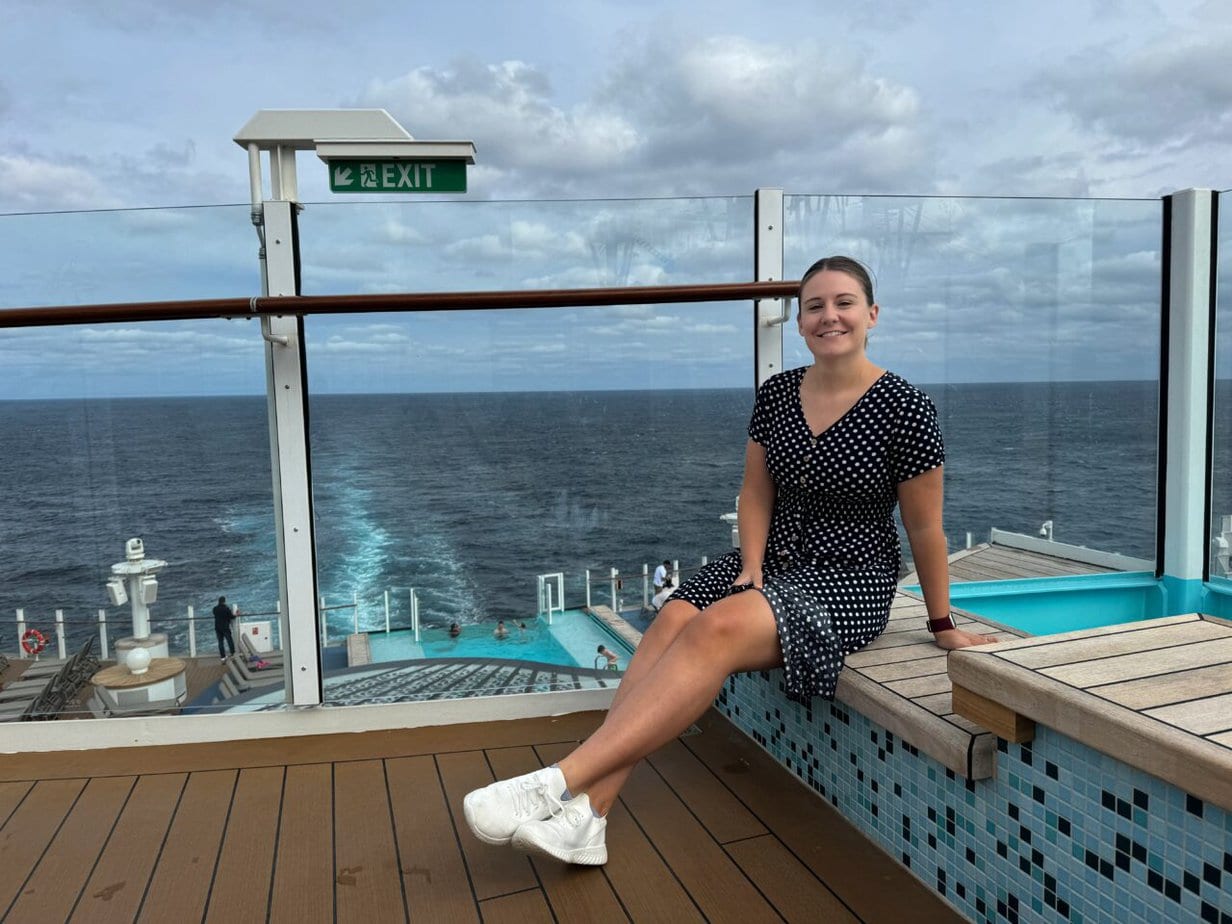
I’m much more likely to get travel sick in a car or coach than a cruise ship. Mum says I could get seasick stepping over a puddle!
Tips to Avoid Getting Sea Sick on a Cruise:
1 – pick the itinerary carefully – avoid a cruise with many sea days.
I rarely go on a cruise with more than two consecutive sea days, this isn’t by accident.
The more sea days you have, the more chance you have of getting seasick. This isn’t just because you’re actually spending more time at sea.
Avoid Transatlantic/Transpacific Itineraries
Cruises with multiple sea days tend to cruise far into open waters, which is usually where bad weather happens.
Transatlantic and transpacific cruises often trigger seasickness in guests and I wouldn’t recommend these for a first cruise if you’re worried about seasickness.
If you are able to pick a cruise with no sea days AT ALL this is a brilliant option. A port a day keeps you busy and also keeps seasickness worries away.
A typical cruise would be docked until around 5/6 pm and arrive early in the morning so by picking a port-intensive cruise you really don’t have that much sailing time.
Some cruises actually visit more than one place a day!
This is rare but I took a cruise with Celestyal which did exactly this. We have one port in the AM and one in the PM. What Celestyal Cruises REALLY Like? – Daily Photo Diary and Review
Avoid Winter Itineraries In Parts of the World Weather is Likely to be Bad
I took a Christmas Cruise from Southampton to the Canary Islands, which travelled through the notorious Bay of Biscay.
With hindsight, this wasn’t a good idea – as we were faced with winter storm after winter storm.
We missed ports, meaning extra sea days, and arrival and departure times on port days were changed
Find out about that Christmas Cruise here:
2 – Stay as Central as Possible With Your Cabin’s Location
If you have the option pick a cabin which is in the middle of the ship.
Cabins in the middle feel less movement than those at the ends. Similarly, if you can pick a cabin on a lower deck this is usually better.
Often times on cruises I’ve found that the theatre and main dining room/buffet are the rockiest places onboard. These are always right at one end of the ship and you can sometimes feel the vibrations from the engine at the back too.
I took a cruise last year on the MSC Meraviglia and when the engine started you really could tell in the main dining room.
We’d be midway through our dinner and then it would start and we would say ‘Oh! we must be off!’
Find out more about the importance of cabin location here:
What is The Best Cabin Location on a Cruise For Avoiding Seasickness? (I’ve Tried Them All!)
Why I don’t follow my own advice on this one: One word, money! I always prioritise money over seasickness.
I often choose a ‘Guaranteed’ cabin which means that you don’t get to choose your cabin location.
It is cheaper to do this but does mean that you are often allocated the ‘leftover’ cabins at the end of the ship or in less desirable locations.
Find out more about that in the article below:
I Always Book Guaranteed Cabins on Cruise Ships – (Photo Examples, Regrets & More)

3 – Treat Yourself to a Balcony Cabin (Or Borrow One)
If your budget allows it, choose a balcony cabin. Being able to open the balcony doors can be a lifesaver if you’re feeling seasick.
I am a big fan of inside cabins and usually cruise in them but when you’re in an inside cabin it is very easy to forget that you’re on a ship at all.
Seasickness is caused by your body being a bit confused, your eyes don’t see any movement but your body feels like you are moving.
For some reason your body decides that the best thing for you is to feel unwell, I assume so that you’ll get out of the situation.
You can’t simply get off the cruise ship so reminding your body why you are feeling the movement by reconnecting with the ocean is a big help.
Borrow Somebody Else’s Balcony
Onboard the MSC Meraviglia, we got caught in a bit of bad weather sailing back from Malta.
I had an inside cabin but was also cruising with my parents who had a balcony cabin.
Being able to go across to their room and sit on the balcony helped me a lot. If you are worried about seasickness, consider saving up for a balcony.
4 – Choose a Mid-Sized Ship
I often see sea sickness-related advice which says that you should choose the biggest ship you can find.
I would disagree with this, some of the newer and bigger ships aren’t designed for ocean travel, they’re designed to have the best facilities onboard.
As a result, the huge mega-ships aren’t always the best for seasickness. I loved my cruise on the MSC Meraviglia but I felt the movement on her a lot more than I have done on some smaller ships.
I would recommend cruising on a cruise ship which contains between 2000 – 4000 passengers. This seems to be the ideal size for me.
New(ish) Ships Are Best
Whatever you do, don’t go for a really old ship. Ships from the 90s or 00’s and later are fine but if you stray much earlier than that you might be more likely to feel seasick.
Stabilisation systems have come a long way in the last few decades. Many older ships have been retrofitted with better stabilisers but if you are worried about seasickness its better to pick a newer ship.
I broke all my own rules and took an “In Search of the Northern Lights” cruise on Fred Olsens Bolette.
The ship was built in 2000, and we were crossing the North Sea in February. I have never felt so sick!
Find out all about that memorable cruise here:
5 – Don’t Overindulge in Food or Drink (But do Eat!)
When cruising, don’t overindulge in food or drink.
This one can be really tricky as for most eating and drinking is one of the most important parts of cruising.
It is much better for you to eat small, regular portions to keep your stomach full but not overeat to the point where you might feel unwell.
Eating particularly greasy or unhealthy foods always increases my chances of feeling seasick.
When I was on P&O’s Britannia, I was sitting in the Beach House restaurant having just finished a massive meal when Captain Wesley made an announcement to warn guests that the sea might be ‘lumpy’.
I knew at this point that I had eaten too much – but it was too late!
I was fine – but still regretted eating all of the Churros and Marshmallows!
Minimising alcohol can be the trickiest part (one or two drinks can actually make you feel better as you stop worrying about feeling seasick…).
On the MSC Meraviglia, I had an unlimited drinks package so tried many beertails. I wasn’t sure if it was the seasickness or the beer making me feel unwell but I always blame the seasickness.
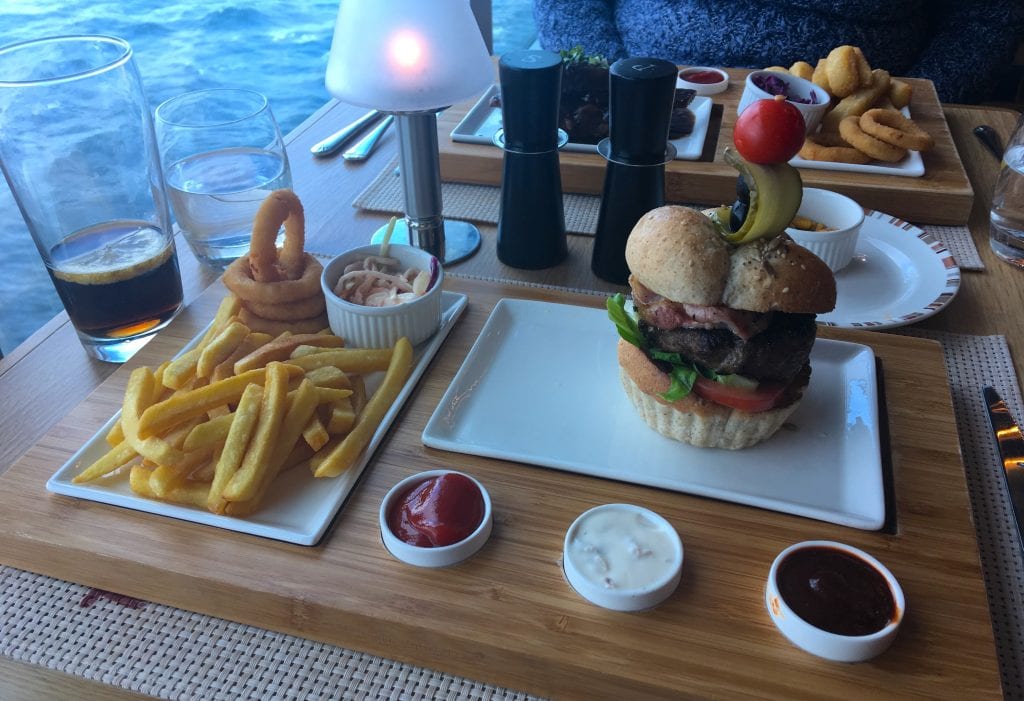
Tips to Treat Feeling Sea Sick on a Cruise:
6 – head outside to find fresh air.
As soon as I feel a little seasick I head straight to the top decks to try and find some fresh air.
A lot of the time this works and I don’t need to follow any other of the steps in this guide.
This works best if you are cruising somewhere which is either windy or rainy. Stepping out into warm air doesn’t help as much as feeling the rain on your face.
Walk a Lap of The Promenade Deck
Not all cruise ships have full promenade decks but I love the ones that do. A lap or two of the promenade deck is usually enough to make me feel better.
Many cruise lines are not building ships with promenade decks anymore because they take up a lot of space.
Cruise lines would generally prefer to keep people spending money inside than walking around in circles on the promenade deck.

7 – Medicate!
If I am still feeling seasick at this point I take seasickness medication.
I usually take Stugeron or Kwells but there are many brands available. Stugeron and Kwells are the only brands that I have found which don’t make me feel too drowsy.
If you are feeling particularly seasick you might want to go to sleep but usually, I don’t.
Is this what everybody else feels like? This is AMAZING! Me, whenever I take seasickness mediciation.
It is definitely worth taking medication if you are feeling that unwell, there is no point struggling through and not enjoying your cruise.
It is worth noting that you can usually get seasickness pills either for free or for a couple of pounds from Reception.
Cruise ship medical centres will also have them, and many offer a seasickness injection for those really struggling with seasickness.
You usually have to pay for the injection and it makes you sleep for quite a while so I wouldn’t recommend this apart as a last resort.

If you do need medical care, you’ll find a fully trained medical team on board along with medical supplies and a medical centre.
To find out more about what happens if you need medical care, including what the cruise lines can and can’t offer, check out this post:
What Happens if You Get Sick on a Cruise? – Simple Step by Step Guide
8 – Sleep it Off
Probably the easiest thing you can do when you feel seasick is to sleep it off. I’ve had many daytime naps when feeling seasick and I usually wake up feeling much better.
Some people find the very slight rocking of the ship to be relaxing.
I’m usually in an inside cabin so I can sleep at any time of day or night. When you’re in an inside cabin and turn the lights off it’s night-time!
9 – Eat Bland, Basic Foods
When I feel seasick, I live on a diet of bread and fruit. Avoid eating heavy meals and definitely, don’t eat anything particularly greasy or fatty.
It’s important not to let your stomach get empty or you’ll end up feeling worse. On occasion, I have felt seasick and decided to take a nap – and I send my brother to the buffet to get snacks for me. Thanks, Max!
The bread shown on the photo below might not look like much but it is SO good.
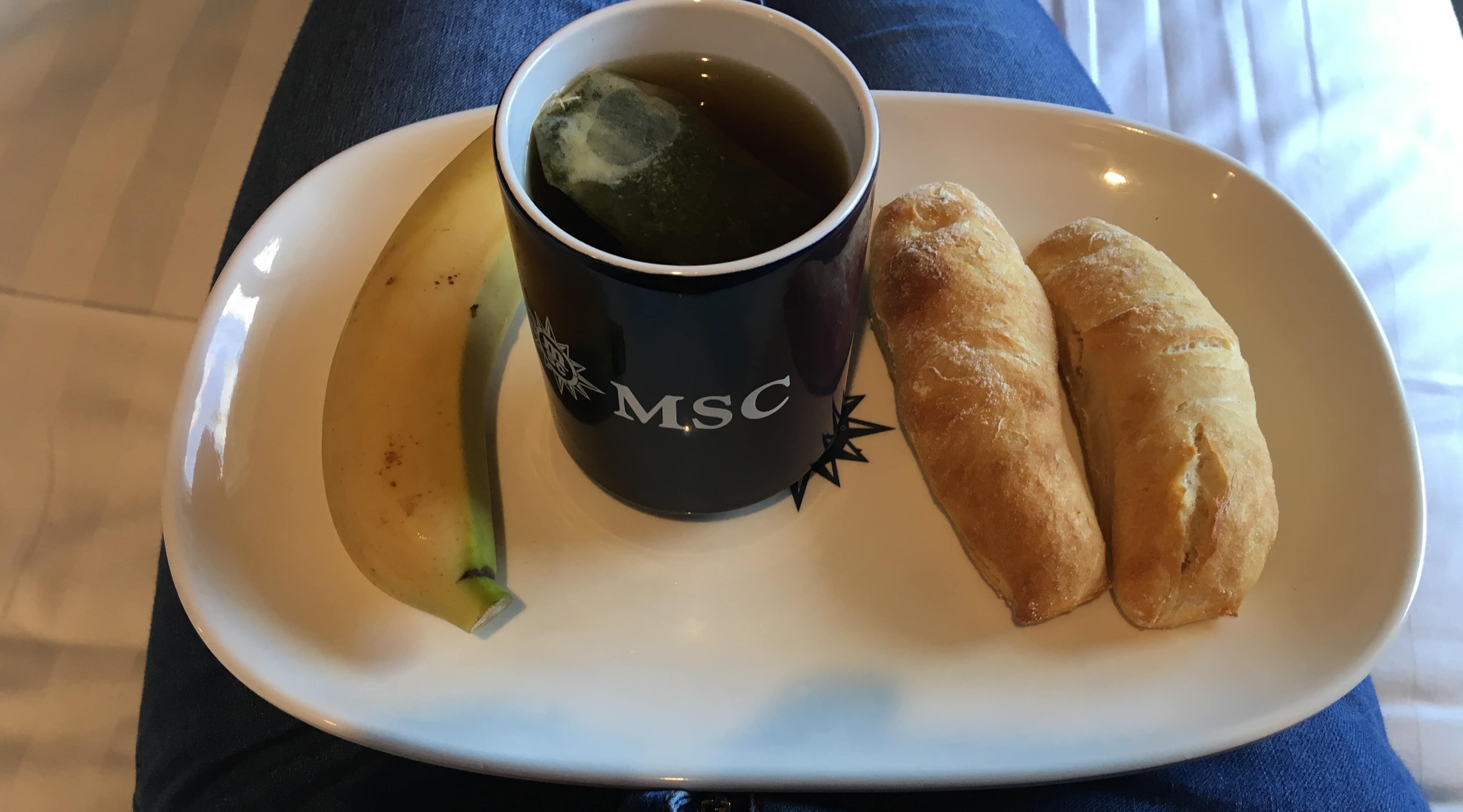
10 – Green Apples & Ginger
I recently heard about eating green apples for seasickness but I thought ‘Hah, that’ll never work’. I’m here to tell you, IT DOES . I don’t know why, or how, but eating green apples really can help with seasickness.
They’re the perfect amount of sweet and crisp to take away that nauseous taste in your mouth. They’re pretty kind on your stomach too so it’s a win all around.
Many people also say that you should eat things containing Ginger. I took this to mean that I should eat ginger biscuits – and I have in the past bought ginger biscuits on long car journeys to try and stop myself from getting travel sick. They also taste great…
I recently bought some ginger-flavoured chewing gum which was meant to have the same effect, I tried one packet and never bought it again, the chewing gum looked like little fish food pellets. Very odd.
Crystalised stem ginger also works and has traditionally been given out on lines in the bygone age, when stabilisers were either not present or much less effective.

11 – Wear a Seasickness Band
I’m not sure if Acupuncture bands actually work – and I don’t know anybody that does.
I do have one and I wear it when I feel like I might get seasick – because I don’t think there is anything to lose by wearing one. Even if it works 1% or works as a placebo, I am happy with that.
The bands work by pressing into the middle of your wrist with a little bump of plastic which sticks out from the band.
It isn’t really uncomfortable but does feel like you’re wearing a tight watch or wristband. They really do indent your wrist.
I remember using one on one of my cruises and I could see the mark for almost a full day afterwards.
You can also buy bands that give you small electric shocks. These are far more expensive.
I have found mine to be a total waste of time as the sensation is worse than the seasickness, so i can’t face wearing it!
It will certainly take your mind off the seasickness though…
12 – Look at The Horizon
If you are feeling seasick, it might be time to put down your phone/tablet and look out at the horizon.
Sitting on a balcony or the top deck looking out to sea can be a really good way to remind your body that you are at sea and that the movement that you are feeling is really happening.
It can be a bit odd sitting in a restaurant or a bar and watching the horizon if you are in bad weather or a storm, the level of the ocean seems to rise and fall.
Despite this, you really don’t consciously feel the movement of the ship very often. It’s our subconscious minds that are the problem!
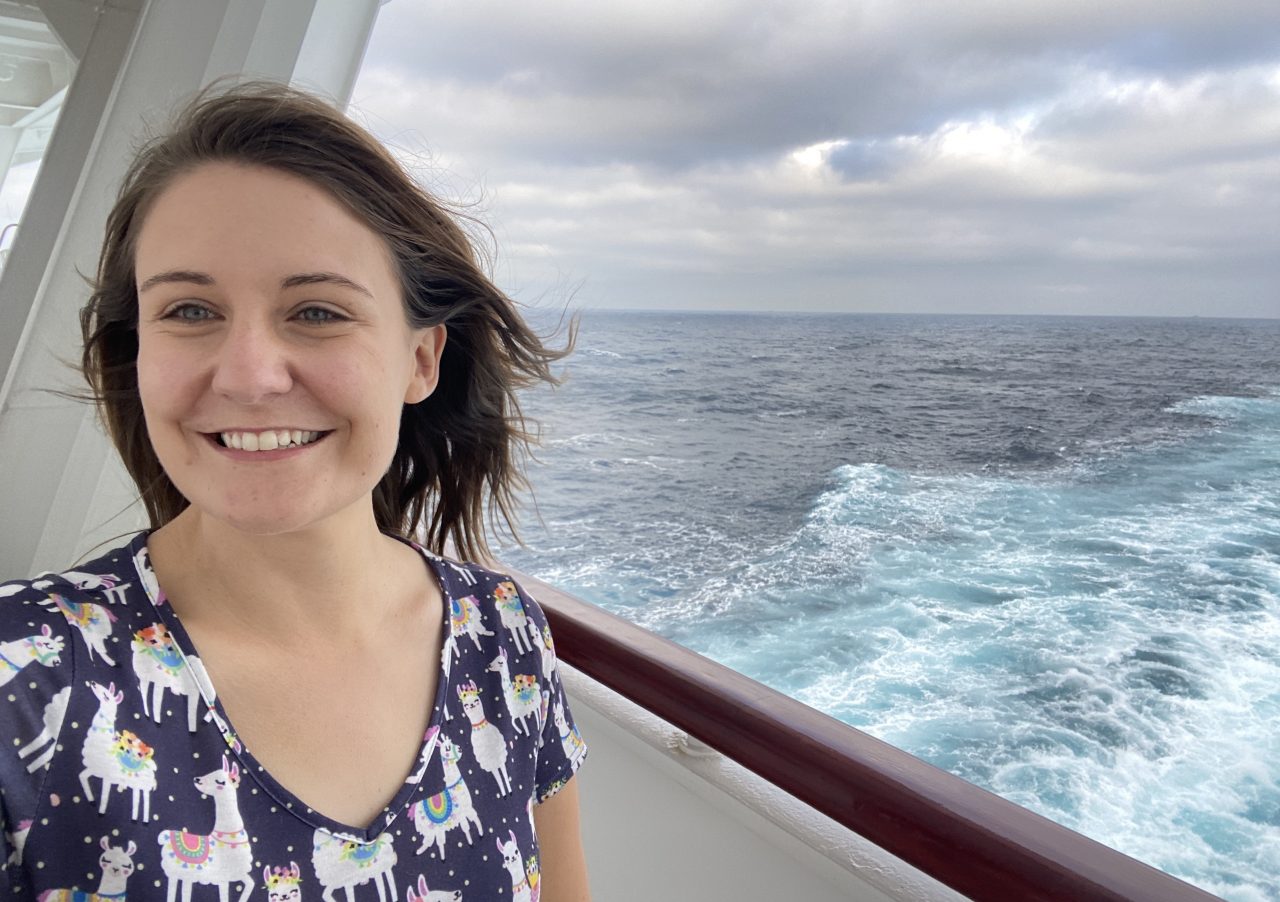
13 – If All Else Fails Sleep on The Floor (I Did)
In a worst-case scenario sleep on the floor if you have to. On my MSC Meraviglia cruise, I was in an inside cabin, which meant that my bed was going sideways.
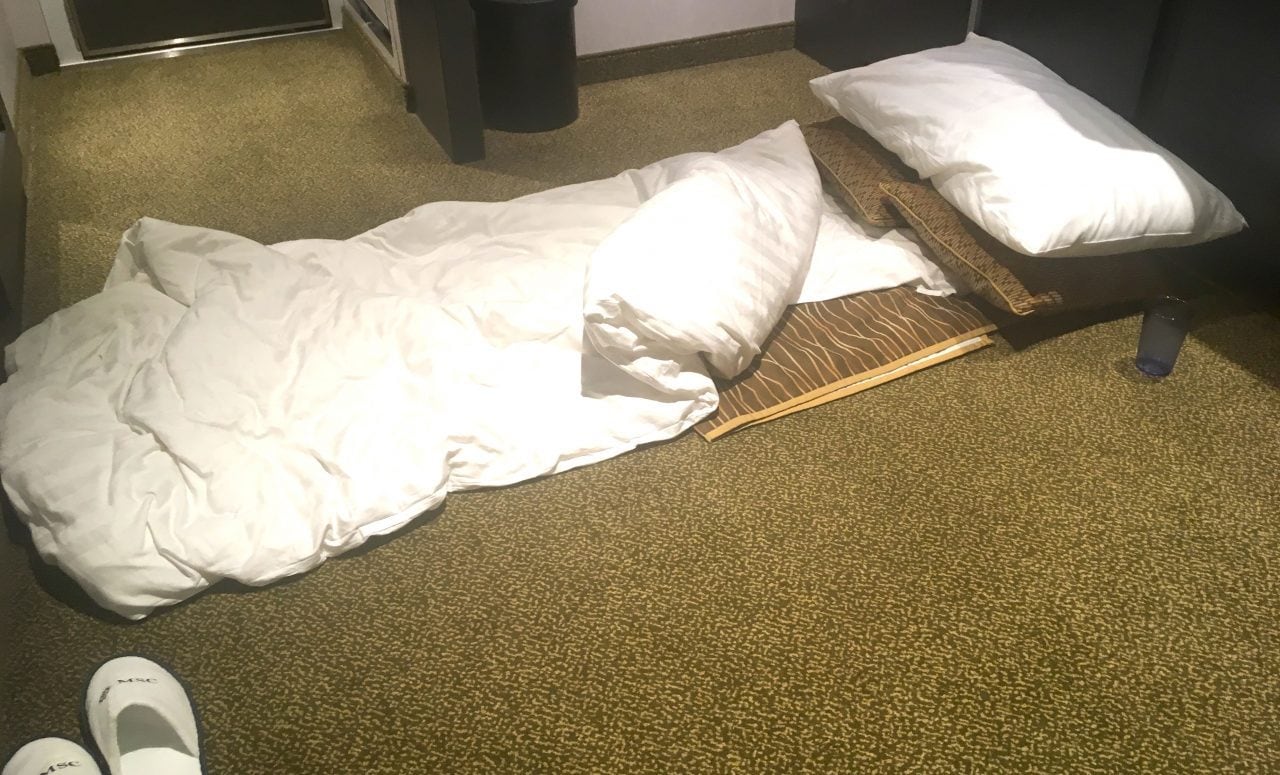
When the ship was moving, I could feel myself going up and down the bed, which was just horrible.
I decided to move my bed to the floor so that I could move side to side, instead of up and down and it was SO much better.
Is Cruising Worth The Seasickness?
I don’t mean to scare you with this post if you are taking your first cruise.
I rarely feel seasick when cruising but obviously had to talk about my seasickness experiences in this post.
I ADORE cruising and I don’t go on cruises assuming that I will be feeling seasick. Even if I do feel seasick, it might be for an hour or at the very most, a day. With the tips in this post, you’ll be prepared even if the worst should happen.
Can You Get Seasick on a River Cruise?
River ships move much much less than ocean ships, there isn’t the constant hum that you get used to on Ocean ships.
River Cruise ships barely move at all, and I have never felt seasick on a river cruise.
River ships often sail at night and spend long days docked in the centre of towns. The travel short differences, compared to Ocean cruise ships.
Find out about the budget river cruise I took onboard Tui Skyla here:
Look at the great range of affordable river cruises Tui offers here*:
*Affiliate link
Before You Go
Find out how to stay healthy when you cruise, and which first aid items to pack “just in case” here:
Staying Healthy When You Cruise, Avoiding Seasickness – Medications and First Aid Items to Pack
Find out about how cruise lines can change their itineraries at short notice to avoid bad weather and rough seas here:
5 Ways Cruise Ships Avoid Bad Weather – and How It’ll Affect Your Cruise

Free Insiders Cruise Line Guide
Enter your email address below:

How to Deal With Seasickness on a Cruise
Afar’s special cruise correspondent has been on dozens of cruises in her life. despite being prone to seasickness, she has mostly avoided it with these remedies..
- Copy Link copied

Don’t let rough waters ruin your cruise vacation.
Photo by Caleb George/Unsplash
I am a cruise writer who suffers from seasickness. But of the approximately 170 cruises I have been on in my life, I have only actually been sick twice, once in particularly strong waves off the coast of Corsica and once when the Pacific was misbehaving off Baja.
I’ve avoided motion sickness on a cruise by bringing the best motion sickness medicines for cruising and by being familiar with factors that contribute to not feeling great—and how to avoid them. For those who don’t know what seasickness is, it starts with your brain getting conflicting information from your inner ear and eyes.
“Inside the cabin of a rocking boat, for example, the inner ear detects changes in both up-and-down and side-to-side acceleration as one’s body bobs along with the boat,” according to the National Oceanic and Atmospheric Administration . “But, since the cabin moves with the passenger, one’s eyes register a relatively stable scene. Agitated by this perceptual incongruity, the brain responds with a cascade of stress-related hormones that can ultimately lead to nausea, vomiting, and vertigo.”
Here are some tried-and-true tips and advice for how to avoid motion sickness on a cruise.
Carefully pick your ship and destination
The medications currently available for motion sickness are strong enough that I recently felt only slightly off while crossing the notoriously rough Drake Passage (sometimes referred to as the Drake “shake”) between Cape Horn and Antarctica , albeit while the seas were mostly cooperating.
Still, you can ensure a smoother ride by sticking to destinations with relatively calm waters. Popular cruise itineraries tend to be on routes that are less prone to rockiness, such as in the Caribbean, Bahamas, and Alaska’s Inside Passage . Once you venture deep into the Atlantic and Pacific, you never know what you’ll get. You may want to keep this in mind if you are a first-time cruiser testing your sea legs.
You’ll experience virtually no seasickness on most river cruises . A great option for those who fear getting seasick are the mostly calm inland waters traversed by river ships.
Modern cruise ships have stabilizers, for a relatively smooth ride wherever you cruise. On big ships with thousands of passengers, you’ll typically feel little movement. Smaller ships may be more of a challenge, but here too you’re likely to find stabilizers. A new generation of expedition ships from brands such as Lindblad Expeditions and Aurora Expeditions are designed with an inverted bow, known as an X-Bow, for a smoother ride.
Choose the right cabin
If you are worried about getting seasick, don’t book a cabin or suite at the very front (or forward end) of the ship, at the very back (aka the aft) of the vessel, or on the upper deck of a ship. These staterooms often feel the most movement. You are better off finding a cabin dead center in the middle of the ship, the most stable area. Also, you might want to make sure you book a cabin with windows so that you can look at the horizon when the ship starts rocking—while it doesn’t work for everyone, keeping your eyes on the horizon can offer a stabilizing effect for some.
The best motion sickness medicines for cruises
If you are worried about being seasick, pack some seasickness medication—options include Dramamine (dimenhydrinate) and Bonine (meclizine). There is a downside to these medications, in that they may cause drowsiness. (There are some nondrowsy options available as well.)
My rule of thumb is to take a half a pill when I first get onboard and until I feel my body has adjusted to the movement of the sea (which may or may not occur after a couple of days on the water). If you have kids who have a tendency to get carsick, you may want to ask your pediatrician about Dramamine for kids that you can give them when they board and as you figure out how they are responding to the movement of the water.
I also listen carefully to the captain’s daily announcements, which usually include a weather forecast for the day ahead. If waves are predicted to be high (more than 15 feet by my standards), I will make sure to take motion sickness medicine—because the reality of the meds is that they don’t really help once you feel sick, so plan accordingly.
If you forgot to pack medication and are feeling ill, ask at the guest services desk or the medical center—they will likely have medicine and the pills are often free.
What if it gets very choppy?
If I am on a route known for rough weather, such as in the Antarctic, I switch out the over-the-counter pills for a prescription Transderm Scop (scopolamine) patch, which goes behind your ear and steadily delivers medication for up to three days. It’s strong and not for everyone, so ask your doctor whether it’s right for you. A downside to the patch is it can make you very thirsty. The patches are also expensive and may not be covered by your health insurance.
In a worst-case scenario, if you are suffering in very rough seas, the ship’s medical team may be able to give you a shot, which can help keep you from getting sick (aka vomiting) but not necessarily from feeling bad.
Homeopathic remedies
Acupressure wristbands , ginger pills , and candied ginger are among the nonmedication ways to deal with seasickness, and some people swear by them. It sounds completely counterintuitive, but you’ll also feel better if you aren’t hungry, according to the U.S. Centers for Disease Control and Prevention (CDC), which recommends eating small amounts of food frequently to help prevent motion sickness. Fortunately, finding food is not a problem on most cruise ships. The CDC also recommends staying hydrated, while limiting both alcoholic and caffeinated beverages.
AFAR’s senior travel news editor Michelle Baran, a fellow sufferer of seasickness, says the wristbands work for her to help avoid getting seasick on a cruise; she also chews mint-flavored gum to help ward off stomach problems when sailing. Similar to seasickness medications, the wristbands will often only work if they are slipped on before the water actually gets choppy (she just puts them on and keeps them on for the duration of the cruise). She will also drink a bubbly soda such as ginger ale or cola and will make sure to look at the horizon to stabilize if she gets motion sickness on a cruise—though, like me, she has mostly managed to avoid seasickness by being prepared with medications such as Dramamine and using the above preventative measures and remedies.
Being out on deck in open air sometimes helps, but my own fail-safe remedy if I am feeling ill and all else fails is to lie down and shut my eyes, and either sleep or listen to music or the TV in my cabin.
Why am I still dizzy after a cruise?
Some people feel like they are still moving when they get off a cruise ship, as their body adjusts to being back on dry land. According to the Cleveland Clinic , this is totally normal, and the symptoms in most cases disappear within a day or two. If they don’t, you may have a rare syndrome known as Mal de Debarquement (MDD) that is still under study. The Clinic recommends you consult with your doctor if the symptoms persist.
>> Next: The Essential Cruise Packing List


How to Prevent Seasickness on a Cruise

Seasickness is hardly fatal, but with symptoms such as nausea, stomach cramps and vomiting, it can certainly feel like it may be -- and it can certainly put a damper on your cruise.
Luckily, cruise lovers have an array of options for seasickness prevention, from medicines and seasickness patches to Sea-Bands and even cabin-booking tricks that can alleviate motion sickness.
When it comes to finding the best prevention method, keep in mind that every person and their response to medication or treatment is unique. Don’t compare yourself to others, as the best remedy for seasickness will be unique to you and your body. Some cruisers find success with a motion sickness patch, while others rely on home remedies like tea.
If you have a propensity to motion sickness or are concerned that you might develop symptoms, read on for a handy breakdown of what causes seasickness and the methods you can use to avoid it with the best seasickness remedies.
What Is Seasickness?
Motion sickness is thought to be caused by the visual disorientation resulting from being on an object in motion (the ship) competing against our body's natural inclination for balance.
Mal de mer, however, is not caused by choppy waters alone. Scientific studies have shown that some folks become seasick by suggestion . They simply convince themselves that being on a ship will make them ill. On the other hand, for those who can forget about it, it's often smooth sailing.
Meanwhile, some people have a genuine proclivity for motion sickness and will undoubtedly suffer more during rough seas.
According to medical professionals, seasickness is more prevalent in children and women (though children under 2 seem to be immune from the ailment). Of equally interesting note, elderly people are less susceptible.
If you’re not prone to seasickness or motion sickness, following some basic tips on how not to get sick on a cruise should ensure you stay healthy while onboard.
Seasickness Medicine Is Often the First Line of Prevention Drug Remedies

Seasickness medicine is easily the most reliable route to keeping the good times rolling on your cruise. You can choose from numerous options, including patches and pills available with prescriptions or over-the-counter medicine .
The Seasickness Patch: One of the Strongest Motion Sickness Remedies
One of the most widely recommended remedies is Transderm Scop, which is a scopolamine nausea patch applied behind the ear at least eight hours before exposure and is effective for up to three days.
Available only by prescription, Transderm Scop is preventive and not a treatment that can also cause possible side effects such as dry mouth, blurry vision, drowsiness and dizziness.
When applying the patch, be sure to clean the area of the skin thoroughly and clean your hands after application. Some substances from the patch may transfer onto your hands and cause more side effects.
If you know you or a family member experience severe motion sickness, bringing a seasickness patch (or several) with you is likely in your best interest. Even if you don’t end up using it, it’s better to have it on hand if things get a little bumpy.
If you’re feeling seasick, a patch may be one of the easiest treatment methods, which is why so many cruisers recommend it.

Prescription-Strength Motion Sickness Medications
Other prescription motion sickness remedies are available from a physician, including promethazine and ephedrine, which, when taken together, produce quick results as well as potential side effects such as sleepiness.
Another option is suppositories administered by the ship's physician , which work magic for some people. Please note that if you or your child cannot keep food or water down and other medicines are not working for you, a suppository may be your best option. Suppositories are often the best remedy for seasickness if you can’t keep anything down.
How Not to Get Seasick With Over-the-Counter Medicine: Dramamine, Meclizine and More
Over-the-counter medications like Dramamine, Meclizine (also known as Bonine) or diphenhydramine (commonly called Benadryl) can also help prevent or alleviate seasickness. On some ships, these are dispensed freely or are sold in the sundries shop.
Remember that the most common side effect of taking Bonine and Benadryl is drowsiness, and alcohol will exacerbate this. Both medicines are available in smaller doses for children , though you should speak to a pediatrician before administering either to your kids. (Learn the differences between Dramamine and Bonine .)
Seasickness Remedies: Drug-Free Options
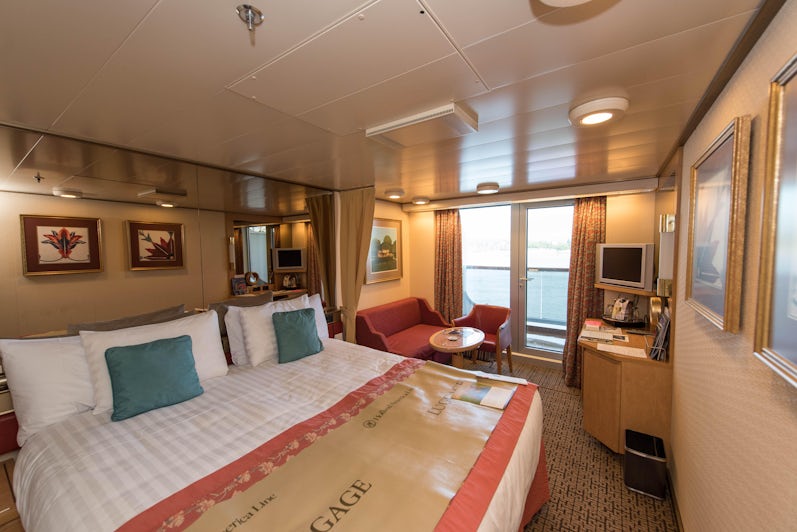
If you don't prefer taking medication, there are plenty of other options if the numerous Cruise Critic boards' threads on seasickness remedies are any indication. From Sea-Bands that help with vertigo sensations to strategic cabin booking, multiple options are available.
How Do Sea-Bands Work Against Seasickness?
Some cruisers swear that applying a Sea-Band wristband the minute you embark can ward off unwelcome motion sickness. The easy-to-wear, acupressure-inspired product has a plastic bead that presses against the Nei-Kuan pressure point located on the palm side of the wrist.
Users say that it eases nausea and vomiting without any side effects. It comes in both adult and child sizes and can be used by pregnant women. Sea-Bands are available without a prescription at major drug stores or on Amazon.
Use the Horizon as Your Personal North Star
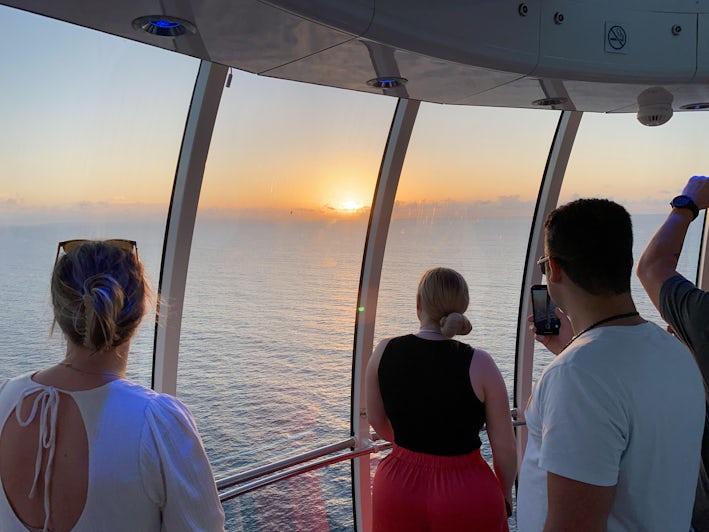
To acclimate to shipboard life, you should spend as much time as possible out on deck once you’ve boarded, using the horizon as a point to maintain your equilibrium.
Booking an outside cabin in the middle of the ship -- the natural balance point -- is another option. Having a window in your cabin will also give you a consistent view of the horizon point, which can help in avoiding seasickness (unless you find yourself in stormy waters with sea spume splashing against your window).
Booking a room with a window works well for many cruisers who experience seasickness. The body is able to regulate itself, and it may mean you won’t need to use prescription medication such as a motion sickness patch.
Get Some Fresh Air to Prevent Seasickness
Some cruisers find that booking a room with a balcony helps them prevent seasickness. Maybe it’s the fresh sea salt air or the fact you can see the horizon, but some cruisers find success in getting much-needed fresh air to remain healthy.
Natural Seasickness Remedies Like Ginger and Apples Could Also Help Onboard
Other cruisers faithfully promote the benefits of ginger, which studies have found alleviates nausea associated with motion sickness. The root can be taken in various forms, including powder, tea, pill and candy.
Some swear that eating green apples helps with nausea, and some ships offer plates of green apples and crackers on their room service menus .
There’s no proven effectiveness to these natural remedies, but some cruisers swear by eating ginger, green apples or crackers and tout them as the best seasickness remedies.
Planning Your Cruise Perfectly Can Also Help Prevent Seasickness
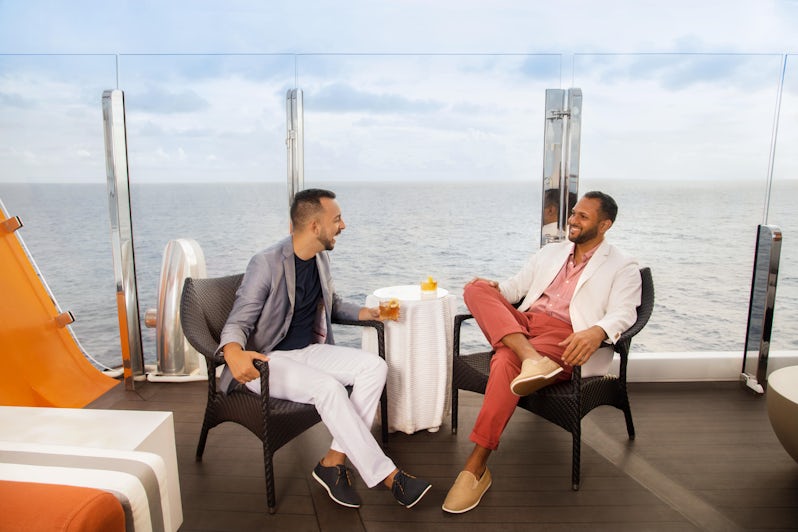
Knowing how to prevent seasickness isn’t limited to pills, gadgets and natural remedies like ginger. A little pre-cruise homework can go a long way in keeping seasickness at bay.
It's not a bad idea to take only port-intensive cruises with fewer days on the open seas if you’re prone to motion sickness or worried you might be. You should also avoid itineraries where the ocean is bound to be rough, such as North Atlantic crossings or the Caribbean during hurricane season .
Another wise option is to pick large, modern ships -- not a difficult proposition with the industry trending toward larger ships. Relatively new mega-ship that weigh 100,000 tons or more have stabilizers which are used when needed to provide the smoothest ride possible.
Always Come Prepared to Treat Seasickness
Come prepared if you know you or a family member is prone to seasickness. Be sure to bring all the essentials in your medical kit. There’s no guarantee that items or over-the-counter medication will be available onboard. If you or a family member experience extreme illness due to motion sickness, contact the medical staff onboard your ship to find a safe solution.
Remember that everyone reacts differently to the various remedies out there. It's on the cruiser to take part in a little research and self-experimentation, and one of the most useful places to start is the Ask a Cruise Question forum on the Cruise Critic message boards .
© 1995— 2024 , The Independent Traveler, Inc.
- Port Overview
- Transportation to the Port
- Uber & Lyft to the Port
- Dropping Off at the Port
- Cruise Parking
- Cruise Hotels
- Hotels with Parking Deals
- Uber & Lyft to the Ports
- Things to Do
- Cozumel Taxi Rates
- Free Things to Do
- Restaurants Near the Cruise Port
- Hotels & Resorts With Day Passes
- Closest Beaches to the Cruise Port
- Tips For Visiting
- Shore Excursions
- Cruise Parking Discounts
- Hotels with Shuttles
- Which Airport Should I Use?
- Transportation to the Ports
- Dropping Off at the Ports
- Fort Lauderdale Airport to Miami
- Inexpensive Hotels
- Hotels near the Port
- Hotels With Shuttles
- Budget Hotels
- Carnival Tips
- Drink Packages
- Specialty Restaurants
- Faster to the Fun
- More Articles
- CocoCay Tips
- Norwegian Tips
- Great Stirrup Cay
- Harvest Caye
- How to Get the Best Cruise Deal
- Best Time to Book a Cruise
- Best Websites to Book a Cruise
- Cruises Under $300
- Cruises Under $500
- Spring Break Cruise Deals
- Summer Cruise Deals
- Alaskan Cruise Deals
- 107 Cruise Secrets & Tips
- Tips for First-Time Cruisers
- What to Pack for a Cruise
- What to Pack (Alaska)
- Packing Checklist
- Cruising with Kids
- Passports & Birth Certificates
- Bringing Alcohol
- Cruising with a Disability
- Duty-Free Shopping
- Cruise Travel Insurance
- Things to Do on a Cruise Ship
- What Not to Do on a Ship
- News & Articles

Will I Get Seasick on a Cruise? Everything to Know About Sailing Comfortably
When it comes to enjoying your vacation, nothing can change things faster than being seasick on your cruise. Meanwhile, it’s said that motion sickness occurs in about 25% of people. So on a cruise with 4,000 passengers, 1,000 may be worried about not feeling their best.
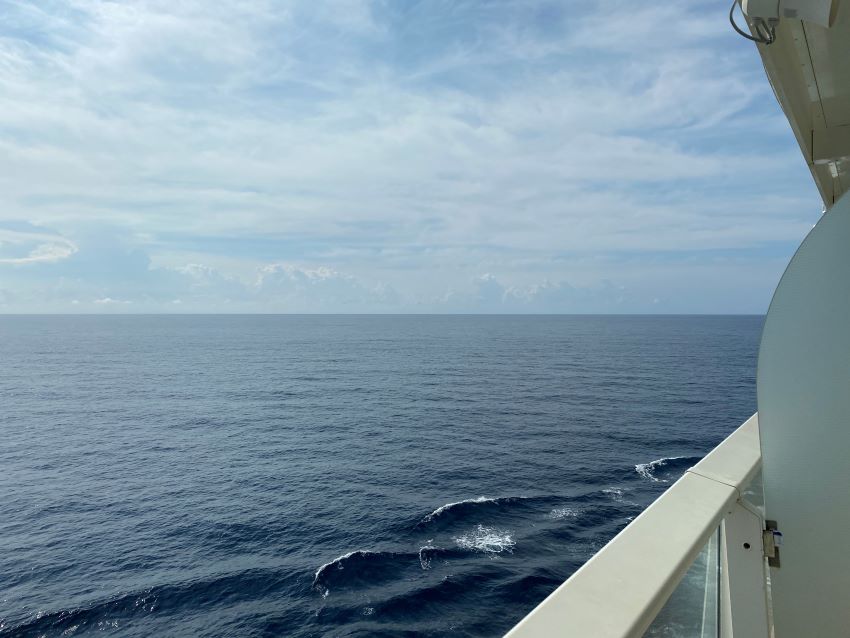
The good news? The number of people feeling seasick is going to be much lower than one in four. Between the stability of the ship and the availability of treatments to keep you feeling good, the number of people impacted by severe seasickness is fairly low.
Even so, those who are susceptible to feeling queasy will have plenty of questions about being seasick while on the cruise. Here’s what to know…
Is the Cruise Ship Rocky When You Sail?
First things first, you’re likely wondering what it’s like to be on the ship in the middle of the ocean. If you’re someone that suffers seasickness, you might be worried that on the ocean the ship will constantly be rocking back and forth.
We can tell you after taking dozens of cruises, that’s simply not the case. There are times where you can feel the ocean’s movement, but it’s usually slight. So instead of feeling a sway back and forth — say, to where you would stagger when you walk — you might feel the ship move just enough to remind you that you’re on the water.
Can it get rockier? Of course, but remember that cruise lines have no interest in a cruise that tosses the ship around. Even if passengers don’t get seasick, it doesn’t exactly make for a fun vacation.
How Does the Ship Stay Stable in the Water?
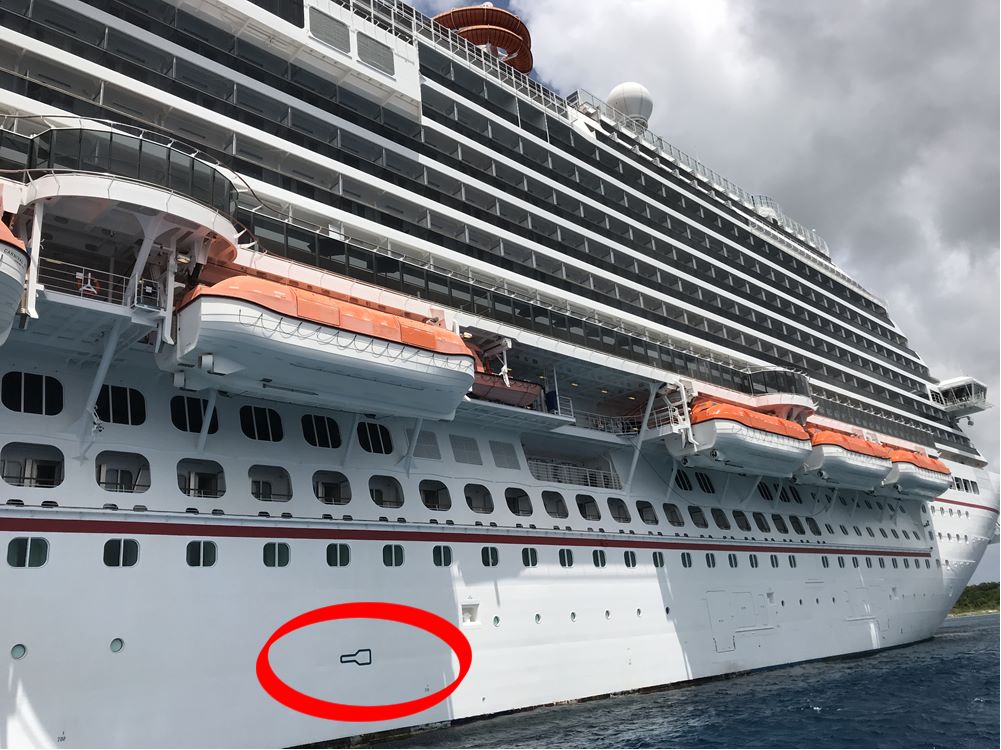
Look at a ship and the fact that it stays stable seems like magic. After all, they can tower high above the water and with everything on top of the ship, they also look fairly top heavy. However, there are ways ships are built and some strategies used to ensure they stay stable while cruising.
First, cruise ships can move. Today’s forecasting tools can offer lots of advance notice about weather conditions. While a ship can’t completely avoid all weather, it does have the ability to maneuver or change course to offer a more comfortable ride when possible.
Even if there is rocky weather, however, it doesn’t mean the ship will be rolling. Modern ships are built with stabilizers under the water. Passengers will never see these, but if you notice a symbol painted on the ship’s hull that looks like a key, that means there is a stabilizer there.
These stabilizers are shaped like a wing that folds out from the ship and cuts through the water. With the wing out, it makes it much harder for the ship to rock back and forth as the wing will push against this type of motion. The result? A much more stable ride.
Do People Get Seasick?
On the vast majority of cruises, we wouldn’t label seasickness as a major issue. For instance, unless you happen to hit weather, you won’t see passengers carrying around paper bags in case they get queasy.
That said, there’s no doubt that some people are more sensitive to motion than others. So, yes, out of the thousands of passengers, there might be some who still get sick.
If you’re someone who easily gets motion sickness, then we highly suggest taking some preventative steps to make sure you will be able to enjoy your vacation.
The good news if you do get sick? Most cruises to places like the Caribbean are at sea only for a day before reaching a port of call. That means there won’t be days on end with no relief. Within short order you’ll be docked, giving you a break.
What Can I Do to Prevent Seasickness on a Cruise?
Still concerned about motion illness while on your vacation? In that case, you can take steps to prevent it so you can have fun on your trip instead of feeling sick to your stomach.
There are plenty of natural remedies out there (eating green apples, ginger, etc.), that may work but we’d suggest something more tried and true. According to the CDC, “commonly used medicines are diphenhydramine (Benadryl), dimenhydrinate (Dramamine), and scopolamine.”
Seattle Children’s Hospital also recommends Dramamine for motion sickness , including for kids as young as two years old.
Bottles of Dramamine and other remedies are available at any drugstore or on Amazon and only cost a few bucks.
Are Remedies Available Onboard?
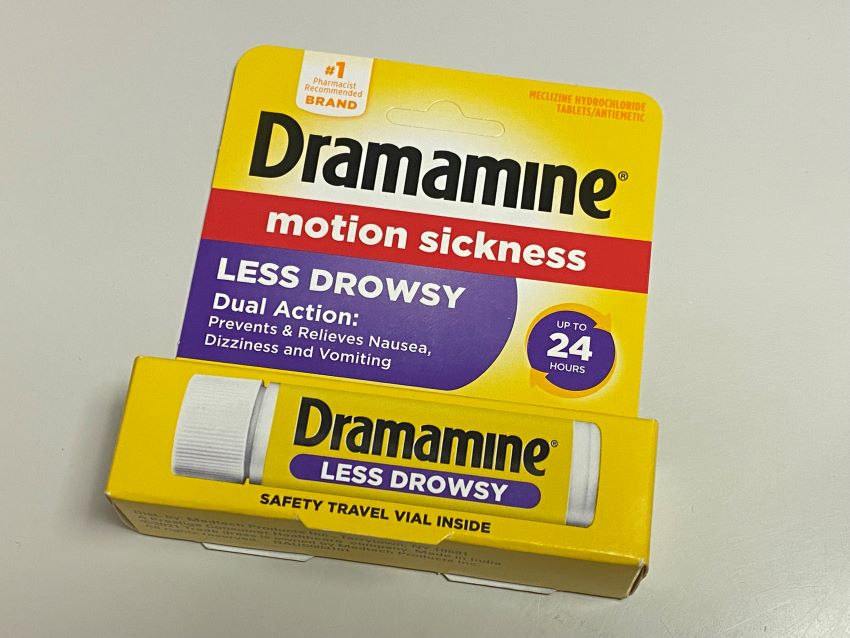
Say you completely forget to bring something for seasickness. Or say you didn’t think it affected you, but some rough weather has your stomach in knots. In that case, you aren’t out of luck.
First, you can head to Guest Services. Often they have seasickness pills available at no charge for passengers who need them.
If there are none there, then each cruise ship will have a shop selling sundries like snacks, toothpaste, batteries, and yes, seasickness medications.
Finally, if you can wait until you are in a port of call, every port area will have some sort of small shop that you can buy items you forget — including medicines — for cheaper than on the ship.
Popular: 39 Useful Things to Pack (17 You Wouldn't Think Of)
Read next: park & cruise hotels for every port in america, popular: 107 best cruise tips, secrets, tricks, and freebies, related articles more from author, 44 must-have alaskan cruise tips, tricks, and secrets, cruise anxiety these facts may calm your biggest fears, how to get from the fort lauderdale airport (fll) to the miami cruise port, 41 must-have tips for cruising with babies, toddlers, or small kids (from someone that’s done it), complete guide to using your phone on a cruise (carnival, royal caribbean & more), gratuity calculator & tipping amounts for major cruise lines in 2024, leave a reply cancel reply.
Save my name, email, and website in this browser for the next time I comment.
7 Easy Ways to Get From the Airport to the Miami Cruise Port
15+ easy port canaveral hotels with cruise shuttles to the ship, hotels with cruise shuttles for every major port in america, 107 best cruise tips, tricks, secrets, and freebies, 39 useful things to pack for your cruise (including 17 you’d never think of).
- Privacy Policy
- Terms & Conditions
- Skip to primary navigation
- Skip to main content
- Skip to primary sidebar
- Skip to footer
TravelAwaits
Our mission is to serve the 50+ traveler who's ready to cross a few items off their bucket list.
How I Finally Discovered A Seasickness Cure That Lets Me Take Cruises

- Cruises and Sailing
- Destinations
- News and Tips
- Travel Tips
- Types of Travel
To say I get seasick very easily is a sick understatement.
I’ve gotten seasick on a 2,000-passenger cruise ship in the Caribbean. I’ve gotten sick on the 100-car auto-ferry that putters sturdily from Lewes, Delaware, to Cape May, New Jersey. I got sick while snorkeling on gentle waves in Baja Mexico, on both a Jetski and a pontoon boat on a tiny lake in Michigan, and even, somehow, while rocking silently in a motor boat roped to a dock.
But I have never vomited. Instead, I become nauseated and disoriented and I simply shut down, withdrawing from any contact or activity with my fellow travelers. I disappear into an exquisitely uncomfortable, dizzy isolation. I am light-headed, inert, and lame-brained.
The symptoms seemed so strange — so different from the toilet-hugging episodes others report — that I began to wonder if this was actually motion sickness at all, or just some idiosyncratic behavioral response to waterborne travel: I hate being here, go away.
But a detailed summary published by the National Library of Medicine validates my experience. For some, motion sickness “may appear to untrained observers as apathy, boredom, irritability, and personality changes.” In more severe cases, it says, one symptom can be “social isolation.”
On the Mexico snorkeling trip, a friend saw how I was behaving and thought my wife and I had gotten into a terrible argument.
It would be so much easier to just puke and be done with it.
Why Motion Sickness Happens
Nearly everybody is susceptible to motion sickness in extreme cases. Friends who have taken small-ship cruises to Antarctica through hellish storms report that nearly all the guests were curled in their beds, with buckets at their sides.
Habituation can reduce the effects, which explains why the crews of those Antarctic ships empty the guests’ buckets instead of filling them themselves. But most of us are not on the water in rough conditions often enough to get used to it.
To oversimplify, motion sickness occurs when the various systems in your body responsible for balance — your inner ear, eyes, bones, and muscles — are in conflict with each other. Let’s say you’re just sitting at a café on the middle deck of a mega cruise ship the size of an aircraft carrier. Your body feels stable. The surface of your cappuccino is placid. You have no view of the sea. But your inner ear registers subtle motion.
This conflict of inputs leads to a cascade of physiological actions, with alarm signals rushing through your brainstem, thalamus, and cortex, finally reaching the vomiting center and resulting in a powerful nausea.
Yes, medical sources call it the “vomiting center.”
What I’ve Tried For Sea Sickness
Because my strong tendency to motion sickness restricts my travel choices, I have diligently tried everything said to work by many others.
- Dramamine, Bodine, Marezine: All are powerful, widely available antihistamines. They knock me out. Worse, they provide little relief.
- The Transderm Scop patch: Widely considered the medical intervention that best balances positive benefits and negative side effects, it’s a prescription patch you wear behind your ear. I gave it a try on a cruise. It helped a bit on calm western Caribbean waters. But the patch made me dizzy and drowsy.
- Ginger ale, ginger candy, ginger supplements: Nope.
- Acupressure wrist bands: You must be kidding.
What Finally Cured My Motion Sickness
Recently, a friend and her new boyfriend Dean — a proud open-water sailor and owner of a 37-foot sailboat he keeps not far from Annapolis, Maryland — invited my lovely wife and me for an afternoon on the Chesapeake Bay.
We wanted to accept the social invitation. Winds were expected to be light, around 10 mph according to the National Weather Service, with waves up to 3 feet.
I told Dean about my delicate constitution, and he said, conspiratorially: Don’t worry, I’ve got you covered.
He assured me he had a medication all sailors use in Europe, the Caribbean, Mexico, and the Mediterranean — everywhere he sails. In most places, it’s available over the counter. While it’s an antihistamine, it doesn’t make you drowsy. Nobody Dean knows bothers with other treatments. It’s the go-to drug for the British Royal Navy.
The drug is called Stugeron, known generically as cinnarizine .
About half an hour before we motored away from the dock, he handed me a plastic-and-foil blister pack. Take one 25 milligram pill, he said. I did.
Miraculously: It worked.
For the first time, I was able to enjoy the water like a normal person. We spent a couple of hours rockin’ around the bay. I realize waves of 3 feet are not rough seas, but they were more than enough to have sent me unprotected into a stupor. Throughout, I was symptom-free. I was able to run ropes through pulleys and fasten them to cleats and so forth.
I was able to feel the breeze on my face and tug my hat against the wind, enjoying the view, the spray, and yes, even the constant bobbing up and down. The monster wakes generated by distant cargo ships didn’t faze me a bit.
Getting Your Hands On Stugeron
The FDA has stubbornly refused to approve Stugeron for sale in the U.S. This is because Stugeron is a calcium channel blocker. Those who take blood pressure medicine recognize this kind of drug can, in rare cases, lead to low blood pressure. The FDA ruled that this exposes too many people to risk allowing its use, even under a doctor’s supervision.
Many other nations’ medical agencies disagree. I am no doctor or medical expert, so I leave it to others to figure out if the FDA is right and everybody else is wrong, or vice versa.
But all this means my new sailing buddy Dean and I simply need to order Stugeron by mail from a Canadian pharmacy. (If you are at risk of low blood pressure, I recommend you educate yourself further before doing so.)
I placed an order. The pills arrived without incident. I feel like a new world of travel opportunities is open to me.
A gourmet small-ship cruise of the Baltic! A remote snorkeling adventure in Australia! A journey among the Greek islands! A small-ship voyage to Antarctica? Who knows?

They live in Bethesda, Maryland, not too far from their two boys, who are both married and fully launched.

Will I Get Motion Sickness on a River Cruise?
River cruises offer a unique and picturesque way to explore and discover new destinations, surrounded by breathtaking landscapes and historic landmarks. However, fear not, as the chances of experiencing seasickness on a river cruise are significantly lower compared to ocean cruises. Rivers are known for their calm and tranquil waters, devoid of the rough seas and unpredictable waves that can often cause the rocking and swaying motion associated with motion sickness. So, sit back, relax, and enjoy the serene journey along the meandering river, knowing that the chances of experiencing any discomfort are greatly minimized.
Is It Possible to Never Get Seasick?
Many people wonder if it’s possible to never get seasick. However, if you tend to get motion sickness from traveling by air or land, it’s a strong indicator that you may not fare well on a boat.
Motion sickness occurs when there’s a conflict between the sensory input your body receives. This can happen when your inner ear, which helps with balance, senses motion that your eyes can’t see.
Even experienced sailors and cruise-goers can develop symptoms in certain conditions or during rough weather.
However, there are preventive measures you can take to lessen the chances of getting seasick and enjoy your cruise to the fullest.
Tips for Preventing Seasickness: This Topic Could Provide Specific Strategies and Remedies That Can Help Individuals Avoid or Reduce the Symptoms of Seasickness. It Could Include Suggestions Such as Taking Over-the-Counter Medications, Using Acupressure Wristbands, Avoiding Certain Foods or Drinks, and Taking Breaks and Looking at the Horizon.
If you’re concerned about getting motion sickness on a river cruise, there are several tips and strategies you can try to prevent or reduce the symptoms. One option is to take over-the-counter medications specifically designed to alleviate motion sickness symptoms. Another possibility is to use acupressure wristbands, which can help with nausea and dizziness. It may also be helpful to avoid certain foods and drinks that can exacerbate motion sickness, such as spicy or greasy foods and alcohol. Additionally, taking breaks and periodically looking at the horizon can help your body adjust to the movement of the boat. By incorporating these preventive measures, you can increase your chances of enjoying a smooth and comfortable river cruise experience.
Planning ahead and taking precautions can help prevent motion sickness on a cruise ship.
Will You Get Sick on a Cruise if You Have Motion Sickness?
Will you get sick on a cruise if you’ve motion sickness? However, that doesn’t mean you’ve to stay home. Avoiding motion sickness at sea starts with smart planning ahead.
One of the first things you can do is choose a river cruise instead of an ocean cruise. River cruises are generally much smoother than ocean cruises, as the ships are smaller and the water is calmer. This can greatly reduce the chances of experiencing motion sickness.
Another strategy is to choose a cabin that’s located in the middle of the ship, on a lower deck. This is where the least amount of motion is felt, as the ships movements are less noticeable in these areas. Avoid cabins towards the front or back of the ship, as they tend to experience more motion.
It’s also important to pack motion sickness medication, even if youre not sure if youll need it. There are several over-the-counter options available, such as Dramamine or Bonine, that can help alleviate symptoms. It’s best to take these medications as directed, either before or at the onset of symptoms.
Lastly, staying hydrated and eating light, easily digestible meals can also help prevent motion sickness. Avoiding heavy, greasy foods and alcohol can reduce the likelihood of feeling queasy. Stick to small, frequent meals and drink plenty of water throughout your cruise.
Therefore, you can relax and enjoy the beautiful scenery and cultural experiences that await you, without worrying about feeling queasy.
Related Posts
How to pack for 2 weeks in europe on a cruise, does the south brooklyn ferry stop at brooklyn cruise terminal, what to do when you board your royal caribbean cruise: a guide, is there a river cruise in sanford, fl.
The Truth About Seasickness
Our chief medical consultant gives us his best tips on preventing seasickness..
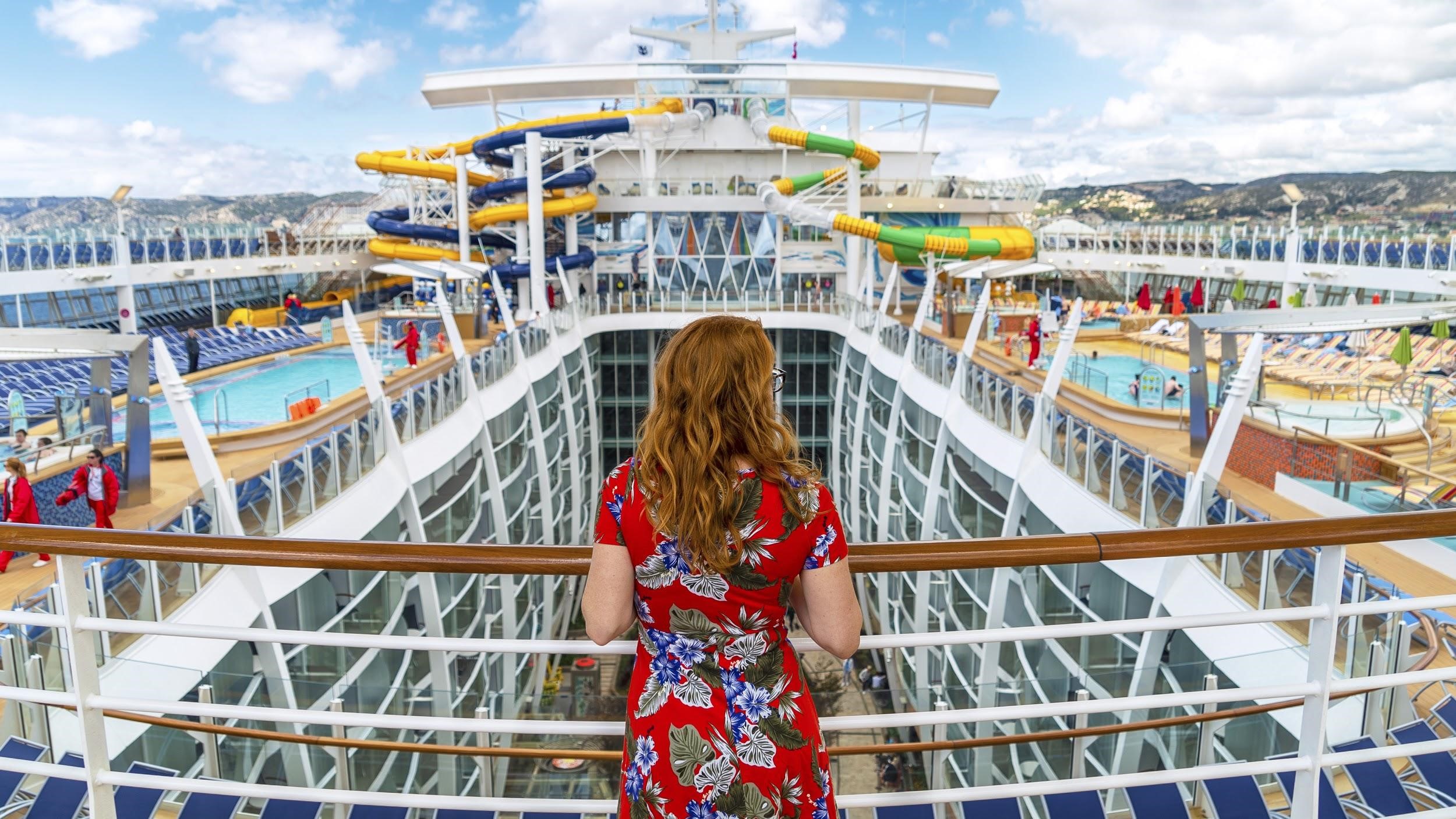
One of the most common questions first-time cruisers have is “What if I get seasick?” We understand where the concern comes from, and we have answers. We’ve enlisted Dr. Benjamin Shore, Chief Medical Consultant at Royal Caribbean, to break down the basics and whether it’s actually common for guests to experience seasickness while vacationing at sea.
“Considering the large size of today’s cruise ships , seasickness is rarely a problem,” says Dr. Benjamin Shore. He adds that with innovative design and engineering, ships can also safely navigate around inclement weather , and use stabilizers—fins built off a ship’s port and starboard sides along the water line—to reduce side-to-side motion so most guests never experience any motion sickness.
Before we get to the specifics, here are the basics: Motion sickness occurs when what you see conflicts with what your inner ear senses. In other words, if you’re sitting in a car (not moving) but your inner ear detects movement (the car just hit 70 mph on the highway), the two signals being sent to your brain don’t match. Those mixed signals confuse the brain, and the sensations and symptoms (dizziness, nausea) are the result.
In the event that seasickness does develop, Dr. Shore assures that it’s unlikely to really interrupt your adventure, since all Royal Caribbean ships have motion sickness medications, like meclizine, readily available at the dedicated Medical Center on each of our ships, free of charge.
“Additionally, for more troublesome seasickness, our Medical Centers also carry promethazine and metoclopramide,” Dr. Shore says.
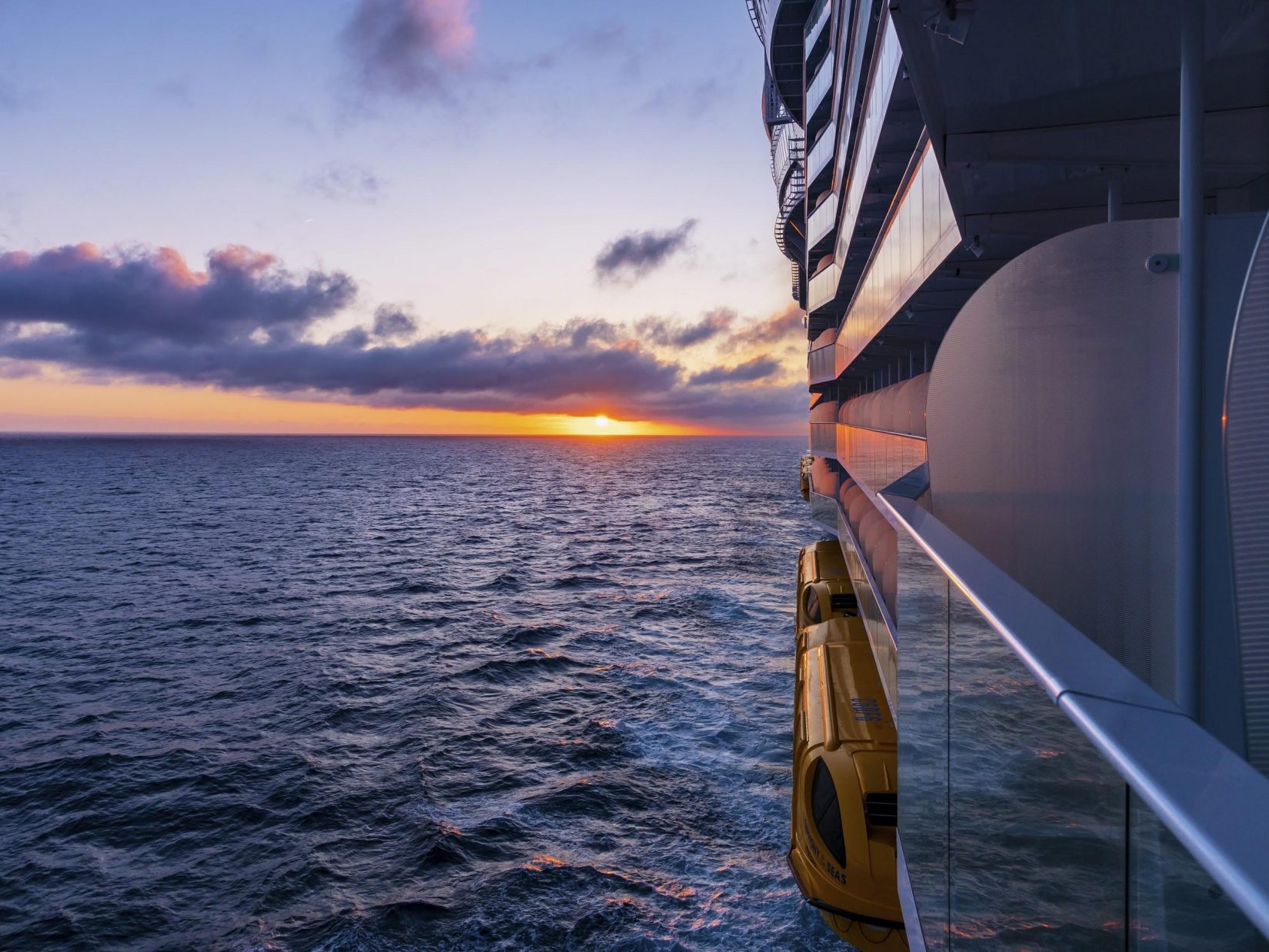
Sometimes the best treatment is prevention. “It’s best that guests who know they are prone to seasickness consult their doctor prior to departure,” Dr. Shore says. If your personal physician thinks it’s appropriate, he or she can prescribe a patch that you can wear to prevent the onset of seasickness. “For prescription patches like Transderm Scop, it’s important for it to be applied prior to boarding to be effective,” he adds.
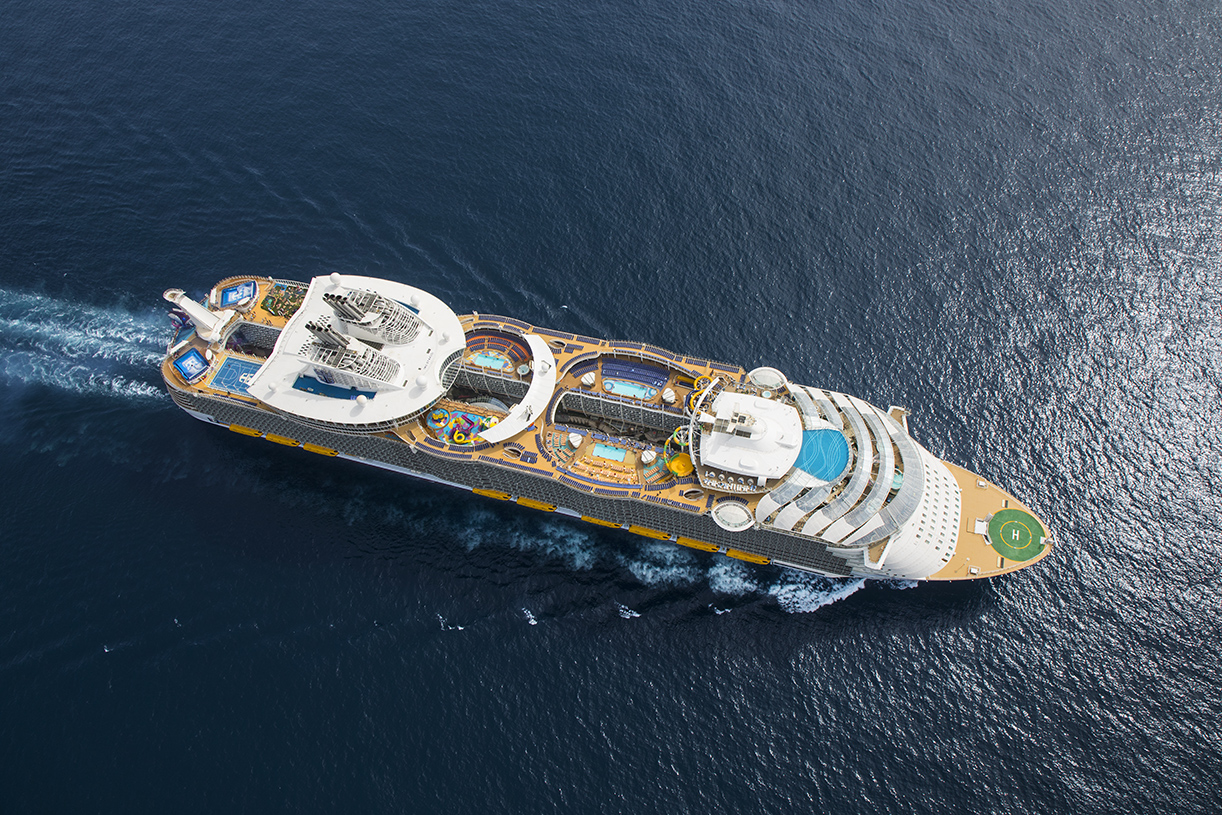
Dr. Shore notes that there are also lots of natural remedies that can help alleviate motion sickness. “Anecdotally, ginger seems to be helpful, and some people find various aromas (like anise, basil, chamomile and peppermint) or eating dry crackers, even after the onset, of seasickness can help.” If a few sips of ginger ale or chewing fresh ginger doesn’t do the trick, he also suggests going for a short walk to the center of the ship, the most balanced area on board and therefore least likely to produce seasickness symptoms.
An unexpected solution Dr. Shore suggests is “the smelling of newspaper print!” He says, “science has no idea why this works so well, but it actually seems to diminish the sensation of nausea.”
With Dr. Shore’s advice and Royal Caribbean’s staff of medical professionals, it’s only smooth sailing for our guests!
If you’re ready to explore Royal Caribbean’s many destinations (more than 260 ports around the world), click here to set sail on your next vacation.
Related Articles

Trend Watch: What Men Are Wearing This Season

Traditions from the Caribbean and Central and South America

A Teen Who's Cruised 50 Times Gives Her Best Tips

Inside The Traveling Newlyweds’ Adventure on Navigator of the Seas
News on cruises, cruise ship reviews and cruising tips
How to avoid seasickness on a cruise and what to do if you feel sick

CRUISE TIPS: Embarking on a cruise is an exciting experience, promising endless adventures on the high seas and picturesque destinations. However, for some travelers, the fear of seasickness can cast a shadow on this otherwise joyous journey. Don’t let motion sickness ruin your cruise vacation! Here’s how to avoid seasickness on a cruise and what to do if you feel sick.

Please note this information is not meant to provide medical advice in any way and is for general reference only. Consult a medical doctor first for what might work for you based on your medical history and condition.
Here’s how to avoid seasickness on a cruise and what to do if you feel sick:
Understanding Seasickness: Seasickness, also known as motion sickness, occurs when there is a disconnect between what your eyes see and what your inner ears sense. On a moving cruise ship, this discrepancy can trigger a range of symptoms, including dizziness, nausea, sweating, and vomiting. Fortunately, there are proactive measures you can take to minimize the risk of seasickness.
1. Choose Your Cabin Wisely to Avoid Seasickness: Selecting the right cabin location can make a significant difference in reducing the effects of motion. If you are prone to seasickness, opt for a cabin on a lower deck and toward the middle of the ship. These areas experience less motion compared to higher decks or cabins located near the bow or stern.
2. Book a Larger Ship for a Smoother Journey: Larger cruise ships tend to be more stable in rough seas, as their size and weight make them less susceptible to rocking and swaying. When planning your cruise, consider choosing a larger vessel to increase your chances of a smoother journey.
3. Focus on the Horizon to Prevent Seasickness: When you find yourself onboard and feeling a bit uneasy, try to focus your gaze on the horizon. Looking out at a stable, fixed point can help your brain reconcile the sensory mismatch and alleviate seasickness symptoms.
4. Stay Hydrated to Avoid Feeling Queasy: Dehydration can exacerbate seasickness, so it’s crucial to stay well-hydrated during your cruise. Drink plenty of water throughout the day and avoid excessive consumption of alcohol and caffeine, as they can dehydrate you further.
5. Eat Light and Mindfully to Prevent Motion Sickness: A full stomach can contribute to seasickness, but an empty stomach can also make it worse. Opt for light, easy-to-digest meals, and snacks to keep your hunger at bay without overwhelming your digestive system. Avoid heavy, greasy, or spicy foods that may trigger nausea.
6. Seek Fresh Air for Relief from Queasiness: Heading out to a deck with fresh air can be beneficial if you’re feeling queasy. The circulation of fresh air can help reduce feelings of stuffiness and nausea. Find a spot where you can sit or stand outdoors for a while to regain your equilibrium.
7. Acupressure and Wristbands: Natural Ways to Alleviate Seasickness: Acupressure wristbands, which apply pressure to specific points on your wrists, have been known to alleviate seasickness for some individuals. Consider using these bands or trying acupressure techniques to see if they work for you.
8. Over-the-Counter Medications for Seasickness Relief: Over-the-counter medications like meclizine and dimenhydrinate (commonly found in motion sickness pills) can provide relief for many people. Consult with your doctor before your cruise to determine which medication is suitable for you and follow the recommended dosage.
9. Ginger and Herbal Remedies for Seasickness: Ginger has long been praised for its anti-nausea properties. You can try ginger candies, ginger tea, or ginger supplements to see if it helps ease your seasickness symptoms. Some other herbal remedies, such as peppermint or chamomile tea, may also provide relief.
10. Stay Distracted to Overcome Seasickness: Keeping your mind engaged can divert your attention from feeling seasick. Engage in onboard activities, attend shows, participate in excursions, or enjoy conversations with fellow travelers to distract yourself from any discomfort.
What to Do If You’re Feeling Seasick: Despite taking precautions, seasickness may still strike. If you find yourself feeling unwell onboard, follow these steps to manage the situation:
- Stay Calm: Panicking will only worsen your symptoms. Take slow, deep breaths and focus on staying calm.
- Head to Fresh Air: As mentioned earlier, head to a deck with fresh air to help alleviate the feeling of stuffiness and nausea.
- Lie Down: Find a comfortable spot to lie down and keep your eyes closed. Resting may help ease your symptoms.
- Stay Hydrated: Sip on water or clear fluids to prevent dehydration.
- Avoid Triggers: Steer clear of strong odors, greasy food, and any other triggers that may worsen your symptoms.
- Seek Medical Help: If your seasickness becomes severe or persists, don’t hesitate to seek medical assistance from the ship’s medical staff.
This is general information on how to avoid seasickness on a cruise and what to do if you feel sick. By following these preventative measures and knowing how to manage seasickness if it occurs, you can ensure a more enjoyable and smooth sailing cruise experience.
You might also like to get the free Cruise Packing Checklist
Share this:

Related News

How to choose the best packing cubes

How to get a job on a cruise ship

7 cruise packing essentials and tips to keep them safe
Discover more from cruiseguru.
Subscribe now to keep reading and get access to the full archive.
Type your email…
Continue reading
Celebrity Blog
- Choosing a Cruise
- Planning / Booking A Cruise
- Preparing For Your Cruise
- Special Occasions
- What To Expect On A Cruise
- Australia, New Zealand & the Pacific
- Central America
- East Coast & Bermuda
- Mexican Riviera
- South America & Antarctica
- Destinations
How to Prevent Seasickness on a Cruise
Last updated: October 12th, 2023
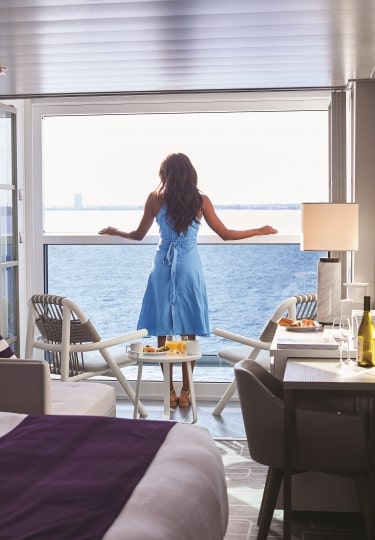
- Find a Cruise
If the only thing standing between you and an unforgettable cruise vacation on one of Celebrity Cruises’ luxury ships is worrying about whether or not you’ll get seasick on a cruise, these tips about dealing with motion sickness will ease your mind and body so you can happily book your cruise.
What causes seasickness?

Seasickness is a form of motion sickness that results when what your eye sees is out of balance with what your inner ear senses. If your body feels motion but your eye doesn’t see it, your senses become confused and can cause symptoms like dizziness, nausea, headaches, and tiredness.
Motion sickness can happen in almost any mode of travel, such as cars, trains, or even on a roller coaster.
How long does seasickness last on a cruise?
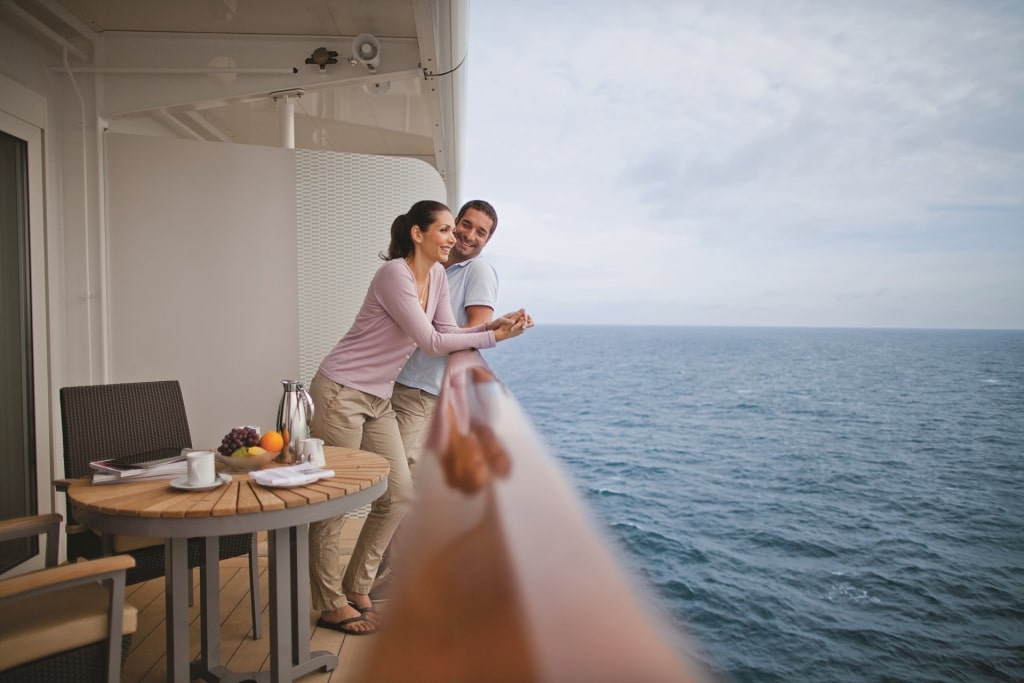
If you feel seasick at the start of a cruise, the good news is that for the great majority of passengers, seasickness usually subsides once you get your “sea legs,” which means your senses adjust and your equilibrium returns.
For most passengers who feel seasick at the start of a cruise, taking over-the-counter remedies and using the techniques recommended in this article will help you feel better in a few hours to a day or two. In some cases, particularly in rougher sea weather, seasickness may last longer.
Can you feel the ship move on a cruise?
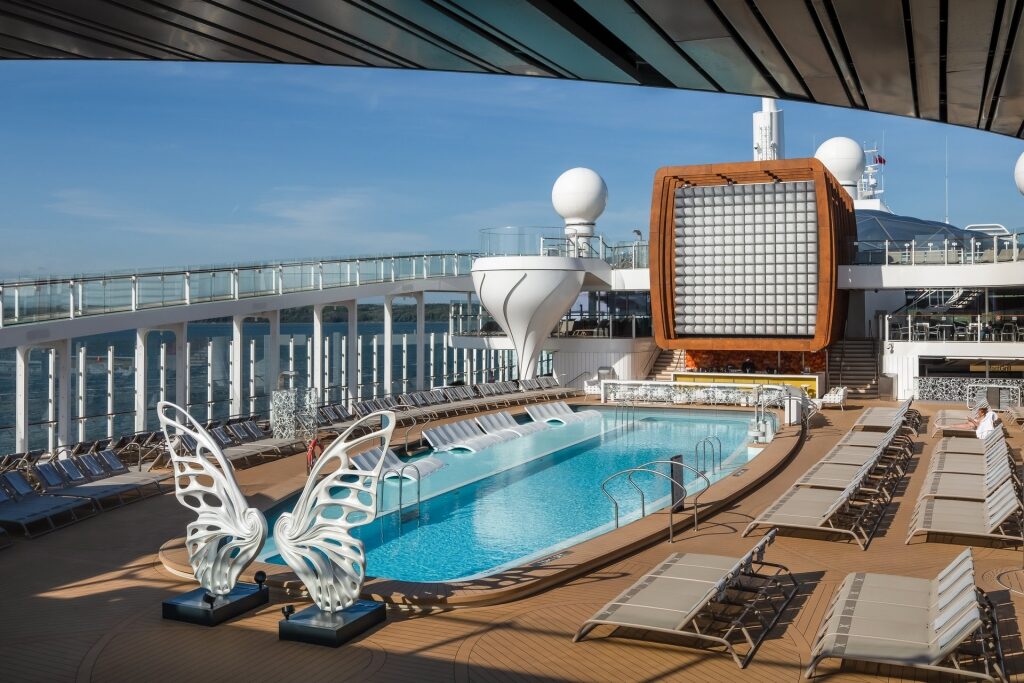
Celebrity Cruises’ fleet of innovative cruise ships are so well designed and engineered that most of the time you won’t even feel the ship moving. Each ship is designed to give you as smooth a ride as possible without compromising the multiple activities available onboard and the spectacular on-deck views.
Our ships have stabilizers to keep the boat from rocking. Even a tilting of 1% is considered unacceptable, and Celebrity Cruises uses advanced technology to make sure your ship stays stable and calm.
What kind of cruise ships are best to avoid seasickness?
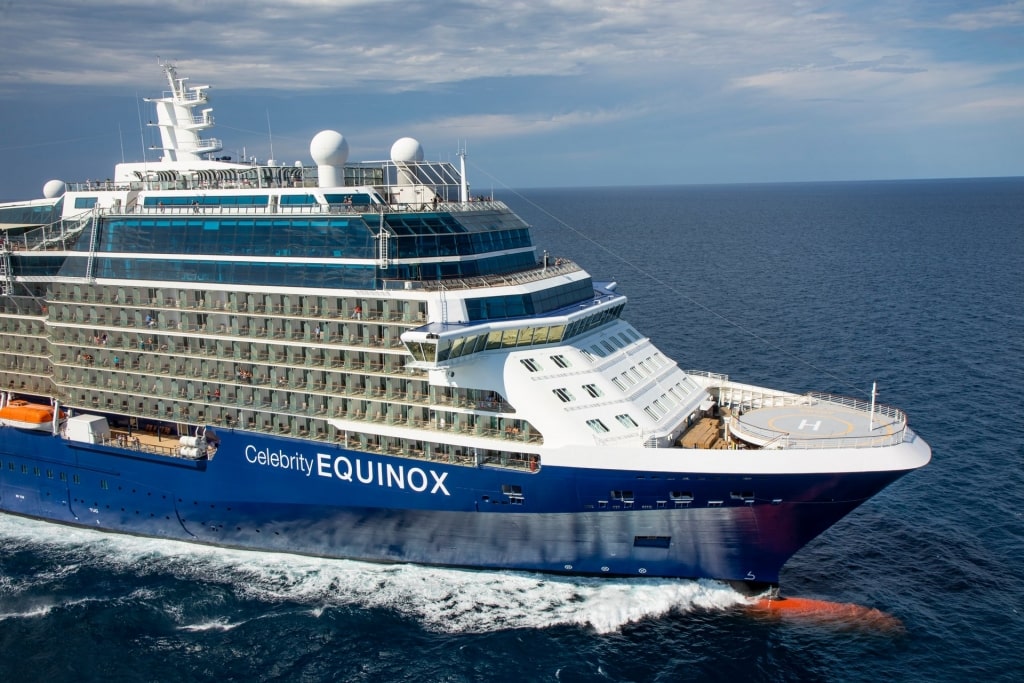
If you’re concerned about being seasick on a cruise, it’s good to know that Celebrity’s Solstice-class ships , which include Celebrity Solstice, Celebrity Silhouette, Celebrity Equinox, Celebrity Eclipse, and Celebrity Reflection, are built for smooth sailing, with fin-like stabilizers mounted beneath the ship’s waterline to ensure smooth sailing.
To give you an idea of the size and heft of these ships, each is built in post-Panamax dimensions, meaning they are too large to sail through the locks of the Panama Canal. At 122,000 to 126,000 tonnes, they glide through the water at a comfortable average speed of 24 knots, or about 27 miles per hour. They are steel-hull constructed and built with the safety and comfort of passengers in mind.
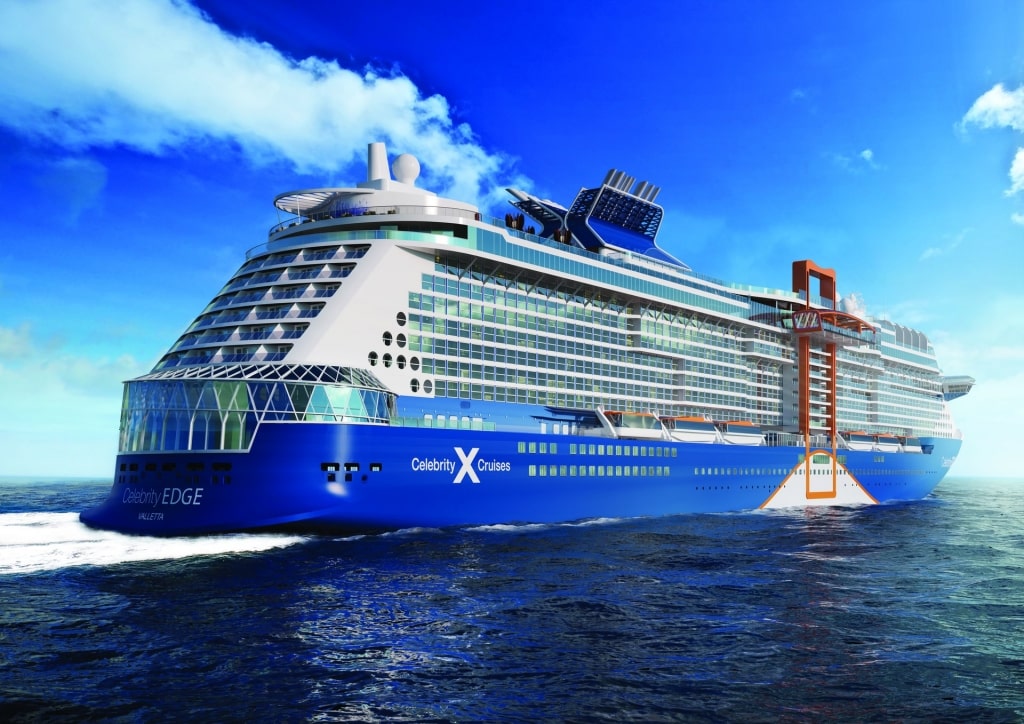
Celebrity’s newest class of ships, the Edge class, which includes Celebrity Edge and sister ship, Celebrity Apex , are the largest ships in our fleet. At 129,500 tonnes and reaching average cruising speeds of 22 knots, or about 25 miles per hour, they, too, are steel-hull constructed with stabilizers to ensure the safety and comfort of the passengers they carry.
Where is the best place to sail to avoid getting seasick on a cruise?

If you know you’re especially susceptible to seasickness, avoid itineraries that spend a lot of time sailing in open water. Cruise itineraries that stay within a sea, such as European cruises that sail along the Mediterranean Sea or Caribbean cruises that depart from San Juan, Puerto Rico are often good bets for having relatively calm waters during cruises.
One way to test the waters if you’re concerned about getting seasick on a cruise is to book a short cruise on a large ship that sails in calm water. We offer 2-night cruises from Florida to the Bahamas on our Millennium-class ship, Celebrity Infinity, and our newly revolutionized Solstice-class ship, Celebrity Equinox.

You’ll have one day at sea in each direction in the usually calm waters between Fort Lauderdale or Miami and the Bahamas. When in port, you’ll have a day to relax and play in the warm sunshine, clear blue water, and white-sand beaches of Nassau .
Another way to minimize your chances of becoming seasick on a cruise is to book a cruise that sails on one of our largest ships, like Celebrity Edge or Celebrity Apex, with 10- or 11-night itineraries that sail within the generally calm waters of the Mediterranean Sea.

Cruise from Rome on a 10-night itinerary visiting some of the most beautiful destinations in the Mediterranean, like Sicily, Naples, and the gorgeous Greek Islands. Or, sail an 11-night itinerary departing from Rome to Naples and Messina, Corfu, Greece, and up the Dalmatian Coast to Dubrovnik and Split, Croatia, and Trieste in Northern Italy.
On each of these sailings, you’ll only have two nights at sea, with the remaining time spent in port enjoying the glorious sights and pleasure of the Mediterranean.
When choosing an itinerary to avoid seasickness, consider the time of year as well. For instance, the best time to cruise the Caribbean is outside the hurricane season—the months of June through November—as they can increase the wave height and the ship movement you might feel while at sea.
Read: Cruising During Hurricane Season
What’s the best stateroom location to avoid motion sickness on a cruise?
To reduce motion sickness, choose a stateroom in the middle of the ship on a lower deck. You will feel any sway of the ship less in this section.
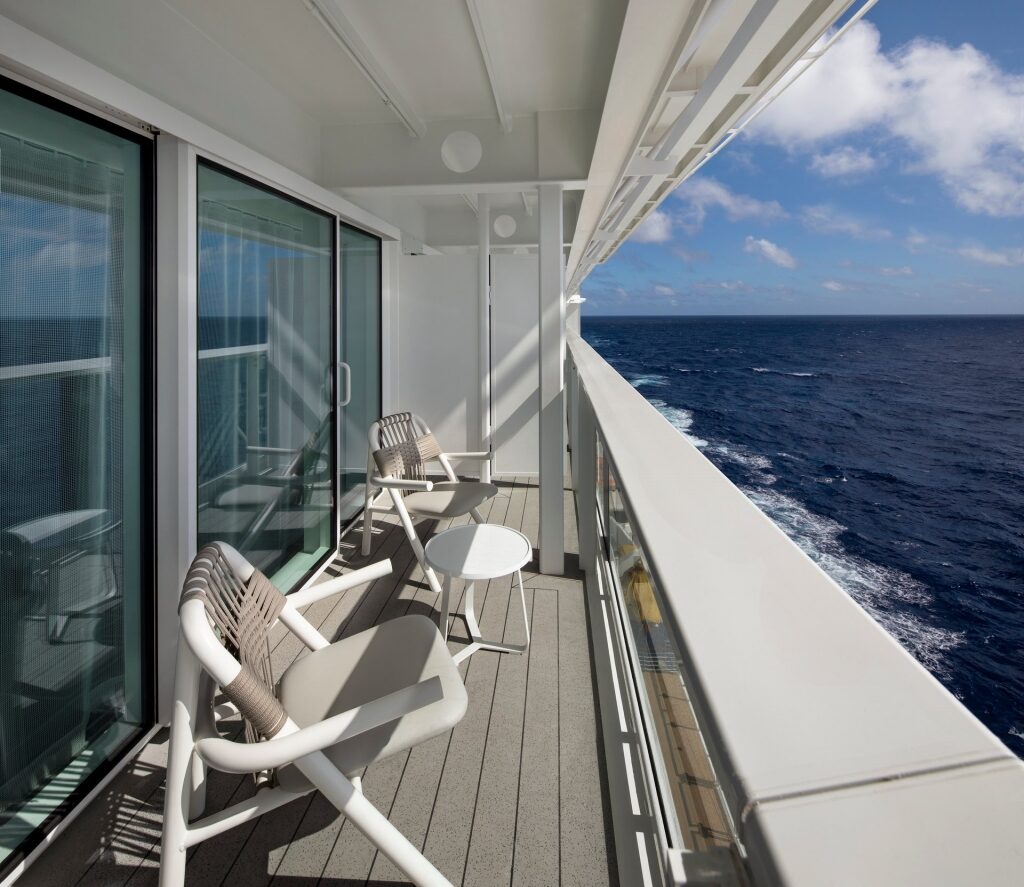
Although it may seem counterintuitive, if you’re worried about seasickness on a cruise, book a stateroom with a window or a veranda. Fresh air access and a horizon view will help alleviate seasickness symptoms.
If lower levels are already booked or you’d like to be on a higher deck for an elevated view or to be closer to the activities on the top decks, book a stateroom in the middle of the ship and avoid staterooms near the front or back (bow or aft) of the ship.
The ships’ deck plans will help you pinpoint the best stateroom location for your needs.
Read: Cruising While Pregnant
What remedies are available to alleviate seasickness on a cruise?
One way to avoid seasickness on a cruise is to get enough rest. Lack of sleep and exhaustion can make you more susceptible to motion sickness.
Motion sickness medication and natural remedies
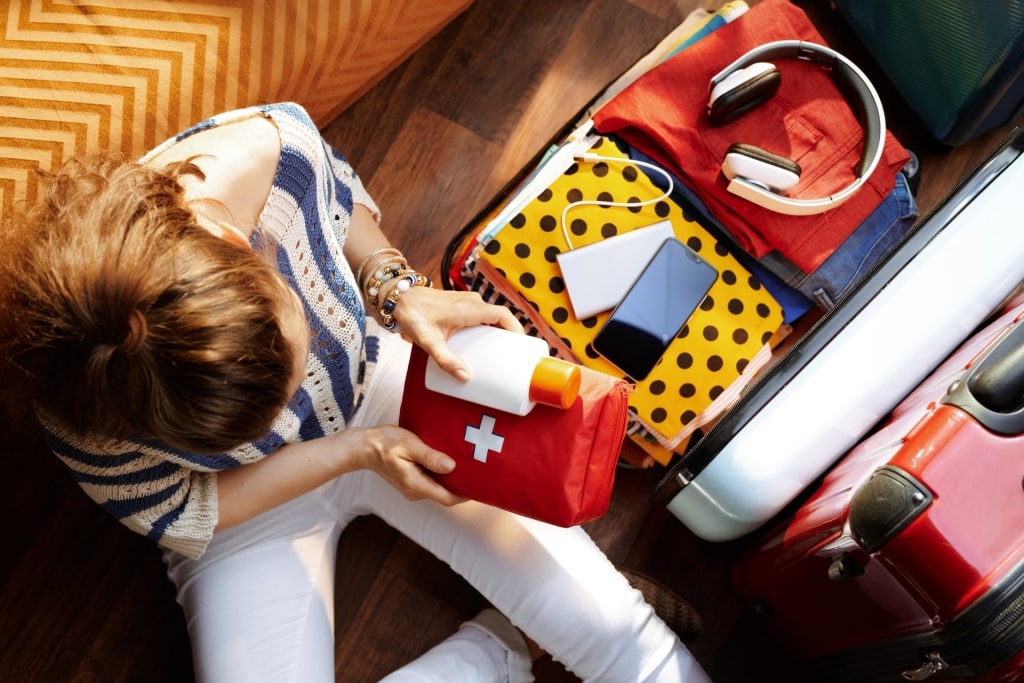
If you think you might experience motion sickness on a cruise, it’s best to be prepared. There are several over-the-counter, natural, and doctor-prescribed remedies that can help. Be sure to pack whatever seasickness remedy you choose in your carry-on bag, and take as directed, which may mean a few hours prior to boarding your ship.
If you have a doctor-prescribed transdermal patch (scopolamine), apply it as directed at least four hours before boarding your ship. The patch is active for three days, so if you’re traveling on a longer cruise, you should pack replacements.
Don’t panic if you forget to pack motion sickness medication. At the guest relations desk onboard, you’ll find tablets that will help combat seasickness.

There are also some tried and true natural remedies to alleviate the symptoms of seasickness. Ginger, whether in pill form or as a candy, is easy to keep handy as you cruise. Sucking on peppermint candy or smelling peppermint oil is also helpful.
Acupressure & acupuncture
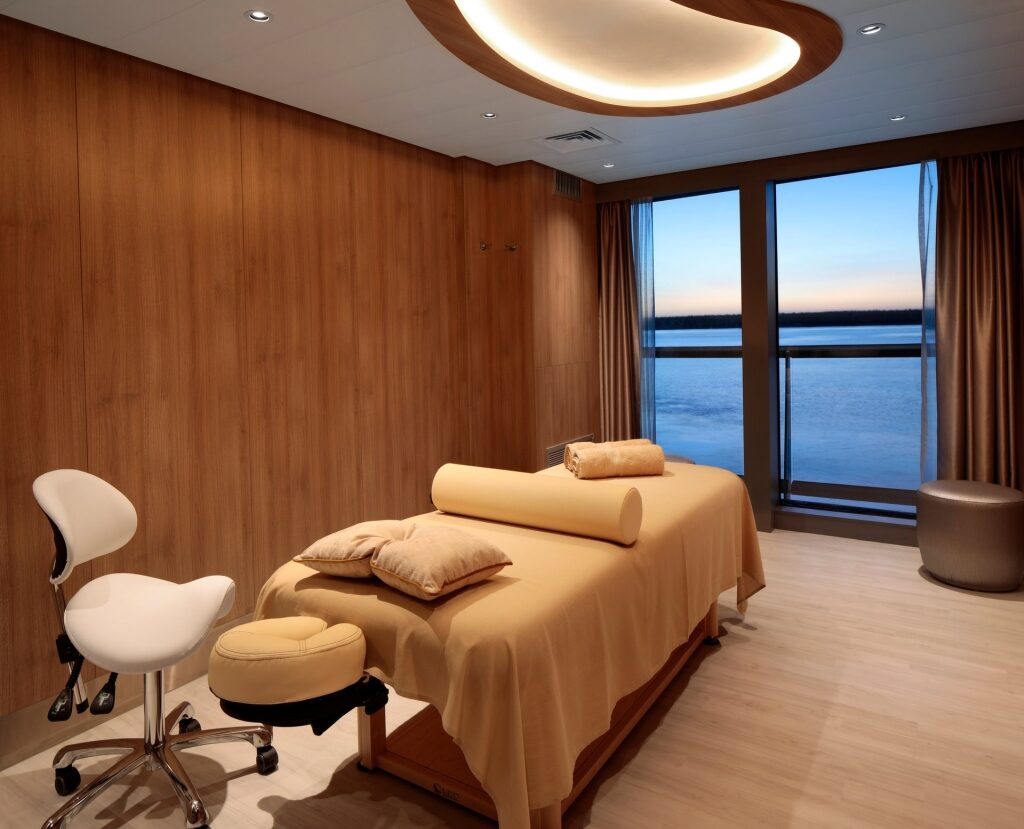
Wearing an acupressure band around your wrist is another natural way to alleviate sea sickness. If you want to take pressure-point therapy one step further, forego the band and seek out an acupuncture specialist. Our onboard spas have acupuncture technicians who will help you relieve your motion sickness.
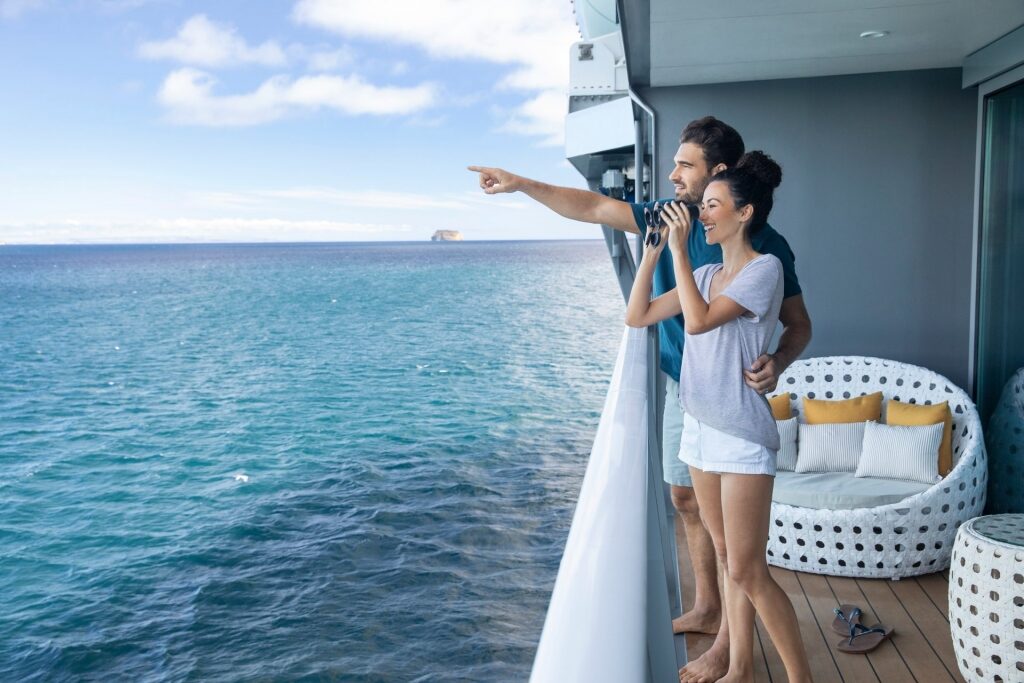
Though being seasick on a cruise may make you want to curl up in your stateroom and stay there, you’ll be amazed at how dramatically better you’ll feel if you get out and breathe in some fresh air. At the very least, step out on your veranda, take a breath of fresh air, find a spot on the horizon, and keep your eyes on it.
Make an effort to get up to the top deck and do the same. Breathing in fresh air while keeping your eyes on the horizon helps your mind and body get back in sync and may alleviate your symptoms.
What should I eat and drink to avoid motion sickness on a cruise ship?
It may sound like the last thing you want to do, but keeping your stomach full by eating small meals and snacks throughout the day can help ward off nausea from seasickness. At the very least, regularly sipping ginger ale and eating crackers may do the trick for the first 24 hours.
If you’re prone to seasickness, be cautious of your alcohol intake as alcohol can increase dehydration and exacerbate the effects of motion sickness.
Staying hydrated during your cruise is vital, as dehydration can make you feel more seasick. Our Zero Proof drink package includes unlimited bottles of sparkling and still water, such as San Pellegrino, Acqua Panna, and Evian.
Now that you know how to combat seasickness, browse our cruise itineraries , view cruise accommodations, fights, and activities all in one place or speak to one of our cruise vacation specialists at 1-800-852-8086.
Related Itineraries
Western Caribbean & Perfect Day
- 5 nights ON CELEBRITY REFLECTION
- DEPARTING FROM FORT LAUDERDALE, FLORIDA
- Starting from $726 USD
Nassau & Bimini
- 5 nights ON CELEBRITY SUMMIT
- DEPARTING FROM MIAMI, FLORIDA
- Starting from $823 USD
Bahamas & Perfect Day
- 3 nights ON CELEBRITY REFLECTION
- Starting from $972 USD
Key West & Bahamas
- 4 nights ON CELEBRITY REFLECTION
- Starting from $2499 USD
Eastern Caribbean
- 7 nights ON CELEBRITY APEX
- Starting from $3819 USD
Bahamas, St. Thomas, & Antigua
- 7 nights ON CELEBRITY BEYOND
- Starting from $5857 USD
Related Articles
What to Wear on a Cruise: The Ultimate Guide
19 Things Not to Do on a Cruise
11 Cruise Picture Ideas
How to Choose a Cruise Drink Package
14 Essential Cruise Packing Tips
How to Choose the Best Stateroom on a Cruise
Cruises for Seniors With Disabilities: Everything You Need to Know
What Deck Is Best on a Cruise Ship?
How We’re Keeping You Healthy at Sea
Cruises vs Resorts: Which Is Best?
What Are Cruises Like?
Best 5-Day Cruises
Free Vacation Planning Services

CALL US 888-751-7804
Sign Up for Special Offers
- First Name *
- Last Name *
- Email Address *
- Country * Country Afghanistan Albania Algeria American Samoa Andorra Angola Antigua and Barbuda Argentina Armenia Australia Austria Azerbaijan Bahamas Bahrain Bangladesh Barbados Belarus Belgium Belize Benin Bermuda Bhutan Bolivia Bosnia and Herzegovina Botswana Brazil Brunei Bulgaria Burkina Faso Burundi Cambodia Cameroon Canada Cape Verde Cayman Islands Central African Republic Chad Chile China Colombia Comoros Congo, Democratic Republic of the Congo, Republic of the Costa Rica Côte d'Ivoire Croatia Cuba Curaçao Cyprus Czech Republic Denmark Djibouti Dominica Dominican Republic East Timor Ecuador Egypt El Salvador Equatorial Guinea Eritrea Estonia Ethiopia Faroe Islands Fiji Finland France French Polynesia Gabon Gambia Georgia Germany Ghana Greece Greenland Grenada Guam Guatemala Guinea Guinea-Bissau Guyana Haiti Honduras Hong Kong Hungary Iceland India Indonesia Iran Iraq Ireland Israel Italy Jamaica Japan Jordan Kazakhstan Kenya Kiribati North Korea South Korea Kosovo Kuwait Kyrgyzstan Laos Latvia Lebanon Lesotho Liberia Libya Liechtenstein Lithuania Luxembourg Macedonia Madagascar Malawi Malaysia Maldives Mali Malta Marshall Islands Mauritania Mauritius Mexico Micronesia Moldova Monaco Mongolia Montenegro Morocco Mozambique Myanmar Namibia Nauru Nepal Netherlands New Zealand Nicaragua Niger Nigeria Northern Mariana Islands Norway Oman Pakistan Palau Palestine, State of Panama Papua New Guinea Paraguay Peru Philippines Poland Portugal Puerto Rico Qatar Romania Russia Rwanda Saint Kitts and Nevis Saint Lucia Saint Vincent and the Grenadines Samoa San Marino Sao Tome and Principe Saudi Arabia Senegal Serbia Seychelles Sierra Leone Singapore Sint Maarten Slovakia Slovenia Solomon Islands Somalia South Africa Spain Sri Lanka Sudan Sudan, South Suriname Swaziland Sweden Switzerland Syria Taiwan Tajikistan Tanzania Thailand Togo Tonga Trinidad and Tobago Tunisia Turkey Turkmenistan Tuvalu Uganda Ukraine United Arab Emirates United Kingdom United States Uruguay Uzbekistan Vanuatu Vatican City Venezuela Vietnam Virgin Islands, British Virgin Islands, U.S. Yemen Zambia Zimbabwe

STAY IN THE KNOW
Thank you for subscribing.
See you on board soon.
- Viking Ocean
Seasickness
By Shirleygibbs , September 12, 2018 in Viking Ocean
Recommended Posts

Shirleygibbs
Hi All,We are taking our first ocean cruise. Can anyone recommend any patch for seasickness? Hoping we don't need any, but I would rather be prepared.
Thanks in advance
Link to comment
Share on other sites, soundcruiser.
Hi, Shirley! How wonderful to be looking forward to your first ocean cruise! As a veteran (?) of two cruises now ( Alaska on HAL and Viking Homelands) and one who gets seasick easily on smaller boats, I'll say that you are much less likely to experience seasickness on these ships than small craft. However, leaving nothing to chance, I go equipped with (1) ginger capsules, (2) seabands that you wear on your wrist, and (3) Bonine (meclizine) . I take a ginger capsule every day, wear the seabands, and take half a Bonine the night before we are due to sail in more open seas, since even a little makes me somewhat sleepy. Haven't had a problem at all, even when the ship was rocking and rolling! Both of our cruises have been mostly through relatively sheltered waters, so I haven't had a severe test yet, but so far, so good.

Baron Barracuda
Had never gotten seasick in almost 40 cruises. Last Feb however suffered inner ear infection which left me with occasional vertigo so asked doctor to prescribe patch for upcoming cruise. Sure enough, first night started feeling wobbly so put patch on. Miraculously it took effect in under an hour and had no recurrence of dizziness. Prescription patches which last 3 days each were not covered by my blue cross plan but weren't very expensive. Now carry them just in case.
My two senses....the patch is referred to scopolamine and is an anti-cholinergic agent. Thou the do work, the side affects of dry month is problematic to many. The old standards of ginger, apples and wrist bands seem to work for many. Personally to get the best bank of buck , I would just stick to OTC Meclizine.
I can get nauseous floating on my back in the ocean. First ocean cruise last year and I took sea bands for both myself and wife. I wore mine all the time and when we did get into some rough weather in Alaska and when others were seasick or feeling very uncomfortable I was just fine and eating normally. Wife was very iffy and I asked her why she wasn't wearing her sea bands. Because I had one on each wrist she thought I was wearing hers. An hour after she put hers on she was feeling better. Just a couple of weeks ago our daughter did a whale watching trip in a Zodiak. She's even worse than me for getting seasick. She used sea bands and was a very happy sailor in some rough water. I also ate some ginger candy from time to time.
We’re on Viking Orion now, for an 8 week cruise from Venice to Hong Kong.
Have had some rough water where guests and crew were sick.
Before leaving, researched a bit and bought DW a ReliefBand. Developed by big pharma company. She has always had a proclivity for motion sickness. But this device seems to work great!

DW has issues with motion sickness.
When cruising she always takes her seabands - just the cheap wrist bands available over the counter. Should be aware that correct placement is critical. She wears these anytime we get a little movement.
When we get into heavy weather she applies a Scopolomine patch behind her ear, about 6 to 12 hours before hitting rough seas, provided they were forecast. In Canada these are available over the counter, but are by prescription in US & UK. Side affect can vary; fortunately DW has no side affects.
Your other options to manage ship motion is to avoid cabins at the extreme fwd & aft ends of the vessel and higher deck cabins. A midships cabin on a lower deck will experience less motion. During the day avoid the Sun Deck, try staying on a lower deck, closer to the ship's centre of gravity.
lackcreativity
I had no problems on our first Mediterranean/Adriatic cruise, but our next one passes through the Bay of Biscay, which I gather can be more problematic. Can someone tell me if ginger candies and ginger capsules are equally effective? Also plan to take sea bands and meclizine, but I'd prefer to avoid the drugs unless really needed.
I am very prone to motion sickness , and I take meclizine one hour before sailing... works great for me.

jiminyC_fan
Huge fan of meclizine. We take it whether or not we need it. We were on a Disney Panama Canal cruise and a hurricane changed it's path in the middle of the night so we ended up having to ride huge swells during the night and into the next day. The waves were covering our porthole. Many crew members and guests were sick. With zero warning people didn't have a chance to take anything in advance. Even people with the patch and ginger had trouble. We on the other hand had a blast. Like all medication it takes time to get in your system so we were ok from the get go because we take it whether or not it's needed. It does not make us sleepy. If you have any questions about the side affects take it at home just to see. That's what we did years ago.
HAL actually kept green apples in our stateroom and we didn't know why until we asked. Thought it was a great idea for others.
I asked at Wal-Mart pharmacy today if they had scopolamine patches in stock. I go do doctor next week, prep for Sept 30 cruise. Pharmacist said their supplier no longer provides them, that I should try Walgreens. I had read of this issue on CC in the past.

Carol From California
Hi All,We are taking our first ocean cruise. Can anyone recommend any patch for seasickness? Hoping we don't need any, but I would rather be prepared. Thanks in advance Shirley
I am very prone to seasickness. I have tried "everything" from Bomine to wrist bands. Nothing worked for me until I got the patch, which is a prescription. I get them every time I cruise and don't worry. There can be side effects but I have not experienced any, other than some dry mouth. It is so worth it to be able to cruise and not have to worry about getting sick. This year we went on a cruise to Antarctica and it even worked going through the Drake Passage, which can be the most turbulent conditions. That is why the chairs are tied down in all the restaurants when you cruise there. With the patch, get enough to cover the length of your cruise. Put the first one on before you get on the ship and change them every 3 days. Check with your doctor.

IF you decide to use "the patch" (which is by prescription in the US and presently has a supply issue due to a recall of several lots)
I HIGHLY recommend doing a 'dry run' b4 the cruise to see how your body reacts to 'the patch' ... the side effects mentioned are just a subset of what's possible. These hit some folks like a ton of bricks. I know from experience!!!!
Be very cautious with ANY alcohol when using the patch and consider this a part of your practice run ..... my story
A few years ago: Father was prone to sea sickness but really wanted to cruise being Merchant Marine during WWII (as a teen). We'd gifted a cruise and he got a 'scrip for the patch and off they went. The cruise had free wine at dinner and he remembered the first glass ..... and nothing for the next 24 hours. BTW he was normally a 2 martini b4 dinner drinker who'd not had them that day. Normally quiet, he became 'the life of the party' ..... Many other details of the story but suffice to say he did NOT tolerate the patch well! In retrospect it is amazing he didn't become a man overboard story!

SargassoPirate
Myth Busters tested all known seasickness remedies by spinning the subjects in a motorized office chair and timed them until they hurled. Ginger capsules won hands down.
IF you decide to use "the patch" (which is by prescription in the US and presently has a supply issue due to a recall of several lots) I HIGHLY recommend doing a 'dry run' b4 the cruise to see how your body reacts to 'the patch' ... the side effects mentioned are just a subset of what's possible. These hit some folks like a ton of bricks. I know from experience!!!! Be very cautious with ANY alcohol when using the patch and consider this a part of your practice run ..... my story A few years ago: Father was prone to sea sickness but really wanted to cruise being Merchant Marine during WWII (as a teen). We'd gifted a cruise and he got a 'scrip for the patch and off they went. The cruise had free wine at dinner and he remembered the first glass ..... and nothing for the next 24 hours. BTW he was normally a 2 martini b4 dinner drinker who'd not had them that day. Normally quiet, he became 'the life of the party' ..... Many other details of the story but suffice to say he did NOT tolerate the patch well! In retrospect it is amazing he didn't become a man overboard story!
Good idea to suggest trying it before the cruise to be sure there are no side effects. I drink (not a lot - mainly wine with dinner) and have had no side effects. Getting seasick is absolutely the worst experience and for me the patch has enabled me to go on lots of cruises with the only side effect being a little dry mouth. I first used it in Alaska and going on helicopter rides to the glaciers and on float planes would normally make me very ill but the patch worked and has enabled me to enjoy cruises and all the adventures. It even worked in the Drake Passage when lots of other passengers on the cruise were very sick.
Unfortunately, ship motion is not that simple. Might work for a motorised office chair, but having spent 40+ years at sea, my experience with real life situations, just doesn't agree that this is a reasonable and scientific study.
While I have not yet experienced a ship movement that makes me seasick, the same cannot be said for DW. Ginger did not work for her in the slightest and I have seen many other passengers taking ginger that didn't fare too well.
In my experience, different remedies work for different people and the remedy that works in one sea condition will not necessarily work in another sea condition. Although not overly applicable to modern passenger vessels, the way a ship is loaded also affects the movement. I have seen people coping in one condition of loading with whatever remedy they are taking and then unable to control the different motion in a similar sea condition, but different state of loading.
Unfortunately, ship motion is a little more complex than rotating a chair.
Unfortunately, ship motion is not that simple. Might work for a motorised office chair, but having spent 40+ years at sea, my experience with real life situations, just doesn't agree that this is a reasonable and scientific study. While I have not yet experienced a ship movement that makes me seasick, the same cannot be said for DW. Ginger did not work for her in the slightest and I have seen many other passengers taking ginger that didn't fare too well. In my experience, different remedies work for different people and the remedy that works in one sea condition will not necessarily work in another sea condition. Although not overly applicable to modern passenger vessels, the way a ship is loaded also affects the movement. I have seen people coping in one condition of loading with whatever remedy they are taking and then unable to control the different motion in a similar sea condition, but different state of loading. Unfortunately, ship motion is a little more complex than rotating a chair.
Thanks for the really good analysis, supported by my experiences on land - a car doesn't make me sick, nor an amusement park ride like that drops like an elevator, but a merry-go-round will do me in.
Our first cruise was fine, but our second has some potential areas that could be a problem. I'll take sea bands, ginger, and meclizine and use them in combination if needed.
I agree ... I can handle 'roll' well (side to side), but 'pitch' can do me in (front to back)!
On one of our early cruises we were seated at a large table ... 8 couples. We got along fine and had wonderful conversation each night ... except one guy who was very quiet ..... His wife mentioned every night how well her 'patch' was working as she's always been seasick b4 .... she was THRILLED with the wonder drug!
The last night of the cruise she excused herself (for personal reasons) and as soon as she was gone Mr broke out in laughter ..... He apologized and shared he was supposed to get the patches the day b4 they left for the cruise but forgot .... so he'd put a round band-aid behind her ear .....
A lot of sea sickness is in the head . . . NOT ALL ..... but a lot.

Great sharing!!!!
Somedayhas arrived
I had this issue at my pharmacy. The generic patches are not available and had been on back order for months. The name brand patches are available. The doctor issuing the prescription just has to say no generics. And my insurance did pay.
Thank you ☺
I know you guys probably won’t believe me but insurance companies do keep track of what generic medicines are in back order and update their system accordingly. I have worked in pharmacy for 15 years. Most of the time a doctor stating no generics isn’t even needed most of the time. But of course better safe than sorry.
The pharmacy I work at is a specialty pharmacy and right now it does not show any generic Transderm patches available. But hopefully it will be available again soon.
Please sign in to comment
You will be able to leave a comment after signing in
- Welcome to Cruise Critic
- ANNOUNCEMENT: Set Sail Beyond the Ordinary with Oceania Cruises
- ANNOUNCEMENT: The Widest View in the Whole Wide World
- New Cruisers
- Cruise Lines “A – O”
- Cruise Lines “P – Z”
- River Cruising
- Cruise Critic News & Features
- Digital Photography & Cruise Technology
- Special Interest Cruising
- Cruise Discussion Topics
- UK Cruising
- Australia & New Zealand Cruisers
- Canadian Cruisers
- North American Homeports
- Ports of Call
- Cruise Conversations
Announcements
- New to Cruise Critic? Join our Community!
Write Your Own Amazing Review !

Click this gorgeous photo by member SUPERstar777 to share your review!
Features & News

LauraS · Started Thursday at 10:20 PM
LauraS · Started Wednesday at 07:36 PM
LauraS · Started Wednesday at 12:53 AM
LauraS · Started Tuesday at 07:17 PM
LauraS · Started Monday at 10:08 PM

- Existing user? Sign in OR Create an Account
- Find Your Roll Call
- Meet & Mingle
- Community Help Center
- All Activity
- Member Photo Albums
- Meet & Mingle Photos
- Favorite Cruise Memories
- Cruise Food Photos
- Cruise Ship Photos
- Ports of Call Photos
- Towel Animal Photos
- Amazing, Funny & Totally Awesome Cruise Photos
- Write a Review
- Live Cruise Reports
- Member Cruise Reviews
- Create New...
- Luxor Tourism
- Luxor Hotels
- Luxor Bed and Breakfast
- Luxor Vacation Rentals
- Flights to Luxor
- Luxor Restaurants
- Things to Do in Luxor
- Luxor Travel Forum
- Luxor Photos
- All Luxor Hotels
- Luxor Hotel Deals
- Last Minute Hotels in Luxor
- Things to Do
- Restaurants
- Vacation Rentals
- Travel Stories
- Rental Cars
- Add a Place
- Travel Forum
- Travelers' Choice
- Help Center
Sea sick on the Nile? - Luxor Forum
- Africa
- Egypt
- Nile River Valley
- Luxor
Sea sick on the Nile?
- United States Forums
- Europe Forums
- Canada Forums
- Asia Forums
- Central America Forums
- Africa Forums
- Caribbean Forums
- Mexico Forums
- South Pacific Forums
- South America Forums
- Middle East Forums
- Honeymoons and Romance
- Business Travel
- Train Travel
- Traveling With Disabilities
- Tripadvisor Support
- Solo Travel
- Bargain Travel
- Timeshares / Vacation Rentals
- Nile River Valley forums
- Luxor forum

I suffer from very bad sea sickness.
It was something I was worried about before my first cruise , but it never came to pass.
Many thanks for your reply. We will take it on board LOL!!!
In my experience, your partner won't suffer from sea-sickness on the Nile. In fact, you can hardly tell that you're moving when you're on the boat as it just glides down the river. It's a wonderful experience not to be missed.
Looking good all round then. So we will start with baby steps and a big boat and give the fellucas a miss, "Too wibbly-wobbly" when I showed her a photo of one!!
Just to reassure you- I have an inner ear problem. I can go on a boat and I am fine but when I get off I walk around like a drunk for a week! I was fine after the Nile trip- a really smooth trip. Enjoy

I can assure you that you will not even know the boat is moving 90% of the time.
It floats like a leaf on a mill pond!
This topic has been closed to new posts due to inactivity.
- Luxor to Aswan Tour One Way 5:45 pm
- Total eclipse: August 2, 2027 1:54 pm
- Cabbies in Luxor 12:53 pm
- Alcohol During Ramadan Apr 08, 2024
- Luxor International Airport (Smoking) Apr 08, 2024
- Mahmoud Taxi Apr 07, 2024
- Advise for taxis and transportation in Luxor Apr 07, 2024
- Best Feteer in Luxor Apr 03, 2024
- Luxor Ferries Apr 03, 2024
- Scooter Rental in Luxor Apr 02, 2024
- Luxor Ferry Fare Increase Apr 02, 2024
- Gobus from Luxor Apr 02, 2024
- MS Hamees boarding and impact of Ramadan/Eid? Apr 02, 2024
- Luxor road from Hurghada Apr 01, 2024
- Getting from Luxor to Hurghada 6 replies
- Best Nile Cruise ship Sonesta Star St George or other??? 5 replies
- Nile Cruise on Ms Semiramis 18 replies
- Shuttle or Taxi from Luxor Airport?? 25 replies
- Boat trip down the nile from Luxor to Aswan 4 replies
- Train from Luxor to Aswan 8 replies
- Hot air balloon ride 51 replies
- Nile Festival cruise 55 replies
- Are inoculations required for entering into egypt 20 replies
- Safaga to Luxor round trip in one day? 8 replies
Luxor Hotels and Places to Stay
- Welcome to the Luxor Forum
- *** The HELP Centre***
- Cruises - General Info.
- *** Cruise Departure Days ***
- Books!!! - Guide Books / Fiction / Non Fiction
- Clothing - Tips on appropriate clothing for visiting Luxor & The Nile Valley
- Health (Vaccinations, Stomach Bugs, Sun Safety etc)
- Entrance Fees 2020/21
- Money, Exchange Rate and Tipping
- Insurance - Advice on getting the right policy
- Mobility - advice on getting round Luxor for anyone with mobility problems
- Public Transport links
- Ramadan in Luxor
- Self Drive in Luxor / Nile River Valley
- Telephone and Internet (Wifi, Moblile Phones, Internet Dongles)
- Transport - (Taxi's, Arabeyas, Trains, Bicycle Hire, Caleches)
- Visas - Fixed Price $25 or On-Line

Cargo Ships, Catamarans, & More: 10 Unique Alternatives To Regular Cruising
T here are plenty of amazing ways to explore the water bodies of the world. While the majority of travelers go with the more popular cruising options, it is exciting to try something new occasionally. These cool alternatives to cruising are super exciting, and even the most adventurous of travelers will fall in love with one of them. Without further ado, here are some epic cruising alternatives to try on one's next adventure.
Submarine Dives
Navy personnel are not the only people that get to enjoy submarine cruises. Travelers can too, and the experience is memorable. Submarine dives offer amazing opportunities to explore parts of the water that ships and divers cannot go to, which can sometimes be up to a thousand feet below sea level.
This adventure is sure to make one feel like a Navy SEAL embarking on a dangerous mission.
Submarine trips in the US aren't super common. However, they do exist. Travelers will have the ultimate experience if they book the best submarine tours in the US .
Whitewater Rafting
Although it does not come with the luxurious amenities of regular cruises, whitewater rafting adventures generate thrills that cruises do not offer. Rafters get a ton of exercise as their muscles battle rapids, and they get splashed with water - rather than just lazying about on a luxury cruise.
There are many destinations around the world where one can spend an entire vacation whitewater rafting. One such place is Costa Rica, where there are plenty of epic whitewater rafting destinations with different classes of rapids. Other places with the best whitewater rafting in the world include the Colorado River in the United States, the Zambezi River in Zimbabwe, and the Mitta River in Australia.
Whitewater rafting may seem similar to kayaking (albeit much more strenuous and exhilarating), but the latter is much different. Kayaking, unlike whitewater rafting, is generally a calmer and more relaxing way to explore the earth’s waterbodies. Although some brave souls use kayaks over vast water bodies, it is generally safer to kayak in smaller waterbodies where there are fewer waves.
Kayaking is a great alternative to cruise ships because it gets people so close to the water and its surroundings. Plus, kayakers can go to places that ships cannot go to. Canoes are very similar to kayaks, so this also applies to them.
Related: Kayaking For Beginners: What To Know & What To Pack
Catamaran Trips
Catamaran boats are double-hull boats, so they are perfect for those who want more space while on their cruise. On catamarans, there is more living space, which makes cruising on these vessels great for families with kids.
Besides the extra space, Catamaran boats are more balanced on the water; hence cruising on these vessels feels more relaxing, even in unstable waters. Due to the reduced rock and roll effects that the sea waves have on catamarans, those onboard will be less likely to suffer from seasickness, too.
Amazon River Cruises
As the name suggests, these are cruises that take passengers through the mighty Amazon River . These cruises are exciting as they offer opportunities to explore the incredible plant and animal life of the largest rainforest in the world.
The Amazon River cruise is arguably the greatest wildlife expedition in the world because there is no place on earth as biodiverse as the forest it goes through. Those onboard these riverboats will feel like some of the greatest explorers in history while on the trips.
River Cruises
While the Amazon River Cruise focuses on one particular river, it is important to note that there are other rivers around the world where one can enjoy exciting cruises.
Although it may seem familiar, river cruises are quite different from the more popular sea cruises because one will be able to see a lot of greenery, wildlife, and cities on the way instead of just being in a massive ship in the middle of a vast sea.
Sailboat Cruises
As more people turn to environmentally friendly modes of traveling , sailboats have become increasingly popular -and they are also exciting. One does not have to be Greta or an avid environmentalist to enjoy sailing. It’s a peaceful and unique experience to cruise on these vessels, especially those with luxury amenities.
Sailboat cruising brings one closer to the water and makes one feel like humans of old who used these vessels to explore the world.
Cargo Ship Travel
Traveling by cargo ship is one of the most unique adventures in the world . It is an opportunity to truly enjoy the serenity of the sea. While they may not come with loads of amenities like cruise ships, the lack thereof is kind of what makes cargo ships so peaceful. This means that even though there may be no Wi-Fi or nightclubs, one will not have to deal with crowded swimming pools and noisy bars.
It is instead a slow and peaceful ride to the next port with plenty of opportunities to get involved in the everyday running of the ship.
Related: 5 Reasons To Consider Cargo Ship Travel (5 Why Not)
Jet Boat Rides
Jetboats are small and fast, and this makes them thrilling ways to explore the waters of the earth. While their small size enables them to reach places regular ships can’t go, their powerful engines make them move with incredible speed.
The excitement that those few minutes riding on these vehicles can bring is arguably more than what hours of regular ship cruises can offer.
Houseboat Rental
Houseboats are on water what RVs are on land. They are homes that are not permanently positioned in a single location but can move to wherever the owner wants. Instead of housing hundreds and even thousands of people at once, as cruise ships do, these houseboats make the experience more personal by only accommodating a few people.
Whether people are spending the vacation with family, friends, or business partners, a houseboat is the perfect way to do it away from land and cruise ships.
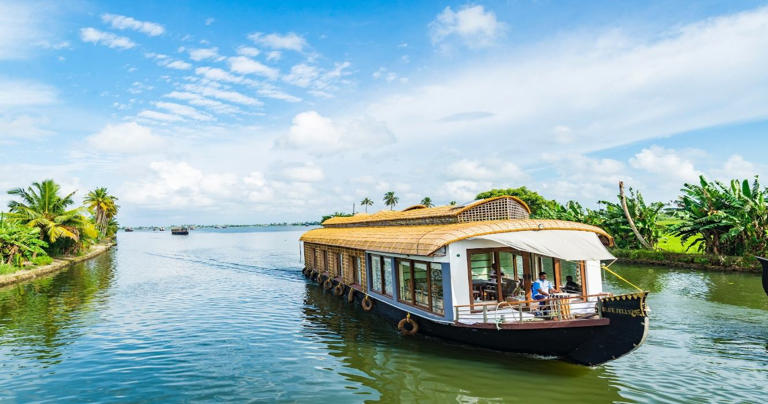

IMAGES
VIDEO
COMMENTS
By: Sherry Laskin · Updated On: February 23, 2021. It's extremely rare for anyone to get seasick on a river cruise. First, there are virtually no waves on a river. Sure, it can get windy, but waves and rocking are almost non-existent. If your river ship is tied up in port at night, you might experience a slightly gentle sway now and then ...
COLUMBUS, Ohio. #13. Posted December 14, 2023. I've done 3 river cruises (Rhine Basel to Amsterdam / Seine - RT to Paris including Normandy / Tulip Time in Netherlands & Belgium - which included sailing on some bigger waterways on the return to Amsterdam). On all 3, I've hardly ever felt any movement with sailing.
They can suggest or prescribe medicine for you to take. Even if you just stick it in your suitcase for emergencies, its a good back-up to have. Hopefully, armed with these tips, you can feel confident in booking a cruise for yourself. Yes, even the seasick can grow some sea legs! Give our agents a call: 800-578-1479.
A: It's highly unlikely that even the most motion sensitive people will suffer from seasickness on a river cruise. The rivers in Europe do not have much motion to them at all, and the river ships are extremely stable. If you are prone to suffering motion sickness from even the slightest movement on the water, try Sea Bands or take an over-the ...
Listen to music, socialize with fellow passengers, or simply relax and take in the sea breeze. 6. Stay Well-Rested. Fatigue can increase the likelihood of seasickness, so ensure you get enough rest before and during your cruise. A well-rested body is better equipped to cope with motion. 7. Pre-Cruise Preparation
Staying hydrated is important for preventing seasickness on a river cruise. Dehydration can make symptoms worse, so be sure to drink plenty of water throughout the day. It's also important to avoid alcohol, as it can dehydrate you and make you more susceptible to seasickness. Stick to non-alcoholic beverages like water, juice, or ginger ale.
I've been on 3 river cruises - 2 on the Danube and 1 on the Rhine. I think a person would have to be EXTREMELY sensitive to motion to experience seasickness on a river cruise. I never heard anyone mention feeling queasy, except for those who maybe spent too much time in the lounge after dinner. 🍷🍸 🍺. Roz.
1 - Pick the Itinerary Carefully - Avoid a Cruise With Many Sea Days. I rarely go on a cruise with more than two consecutive sea days, this isn't by accident. The more sea days you have, the more chance you have of getting seasick. This isn't just because you're actually spending more time at sea.
The CDC also recommends staying hydrated, while limiting both alcoholic and caffeinated beverages. AFAR's senior travel news editor Michelle Baran, a fellow sufferer of seasickness, says the wristbands work for her to help avoid getting seasick on a cruise; she also chews mint-flavored gum to help ward off stomach problems when sailing.
Fortunately, the chances of getting motion sickness on river cruises are much slimmer. It is extremely rare to become seasick on a river cruise as the waters are much calmer. No waves or rough seas on a river means rocking is non-existent. Plus, river ships move at a fraction of the speed of ocean vessels so there is hardly any speed to create ...
River cruises excel at offering slow travel without swells and with frequent port stops. ... Medications, such as Dramamine, may be a packing necessity if you know you are prone to sea sickness.
Luckily, cruise lovers have an array of options for seasickness prevention, from medicines and seasickness patches to Sea-Bands and even cabin-booking tricks that can alleviate motion sickness.
September 3, 2023. When it comes to enjoying your vacation, nothing can change things faster than being seasick on your cruise. Meanwhile, it's said that motion sickness occurs in about 25% of people. So on a cruise with 4,000 passengers, 1,000 may be worried about not feeling their best. Unless you suffer from extreme motion sickness, it's ...
To say I get seasick very easily is a sick understatement. I've gotten seasick on a 2,000-passenger cruise ship in the Caribbean. I've gotten sick on the 100-car auto-ferry that putters sturdily from Lewes, Delaware, to Cape May, New Jersey. I got sick while snorkeling on gentle waves in Baja Mexico, on both a Jetski and a pontoon boat on a ...
River cruises are generally much smoother than ocean cruises, as the ships are smaller and the water is calmer. This can greatly reduce the chances of experiencing motion sickness. Another strategy is to choose a cabin that's located in the middle of the ship, on a lower deck. This is where the least amount of motion is felt, as the ships ...
In the event that seasickness does develop, Dr. Shore assures that it's unlikely to really interrupt your adventure, since all Royal Caribbean ships have motion sickness medications, like meclizine, readily available at the dedicated Medical Center on each of our ships, free of charge. "Additionally, for more troublesome seasickness, our ...
Get fresh air. When you're feeling seasick, the fresh air of being outdoors can help ease the nausea and dizziness. Going up to a deck with an open view can be calming. It helps to feel the breeze on your face and be in nature. If possible, try to find a spot where you can lean on something that's secure. Focus on the horizon and try to relax.
4. Stay Hydrated to Avoid Feeling Queasy: Dehydration can exacerbate seasickness, so it's crucial to stay well-hydrated during your cruise. Drink plenty of water throughout the day and avoid excessive consumption of alcohol and caffeine, as they can dehydrate you further. 5.
Cabins mid-ships (in the middle of the ship) and lower down are best. If the sea is a little rough, the higher the deck the more it will be felt, Those cabins at the very front or very back will also feel the movement more. Try to spend as much time as you can on deck as fresh air, especially a sea breeze will help you feel better.
To reduce motion sickness, choose a stateroom in the middle of the ship on a lower deck. You will feel any sway of the ship less in this section. Although it may seem counterintuitive, if you're worried about seasickness on a cruise, book a stateroom with a window or a veranda. Fresh air access and a horizon view will help alleviate ...
Choosing the Best Stateroom Location. Middle of the Ship: If you're prone to seasickness, a cabin in the middle of the ship (midship) is an excellent choice. The center of the ship is the most stable, experiencing less motion than the front (forward) or back (aft) of the ship. The lower and more centrally located your cabin, the less roll and ...
Most probably the river is not more than 3- 400 meters wide maximum. Waves really do not exist and perhaps just a slight wake from passing ships. These cruise boats while not big are large enough where you feel little if any motion. Boats thus are quite steady . I do not believe motion sickness would be a problem for most people.
August 17, 2011. RAMSEY, NJ. #4. Posted September 12, 2018. Had never gotten seasick in almost 40 cruises. Last Feb however suffered inner ear infection which left me with occasional vertigo so asked doctor to prescribe patch for upcoming cruise. Sure enough, first night started feeling wobbly so put patch on.
I suffer from very bad sea sickness. I've been on quite a few Nile Cruises and never once got motion sickness. Cruising on the Nile and Cruising at sea seem to be two completely different things. The Nile is almost completely smooth and there is no rolling motion like at sea. It was something I was worried about before my first cruise, but it ...
Get set to explore the rivers of the world with a leisurely river cruise. Here's what to expect as a first timer. 1. Smaller ships. The type of ship will depend on the destination and route you ...
Although it may seem familiar, river cruises are quite different from the more popular sea cruises because one will be able to see a lot of greenery, wildlife, and cities on the way instead of ...